Your Garnelio Aquarium Guide - Part 1
Table of contents
- We are here for you
- It all starts with the right aquarium!
- Aquarium types
- Location
- Aquarium furniture
- Technology in and around the aquarium
- Lighting
- Filters - the heart of the aquarium
- Shrimp-proof filters
- Internal vs. external filter
- Backpack filter to hang on
- Heating and cooling in the aquarium
- Aquarium cooling
- Aquarium heating
- Water treatment with osmosis system
- Conductivity and microsiemens
- Removal of pollutants by reverse osmosis
- How an osmosis system works
- pH-value meter
- Technology in a marine aquarium
- Substrate and nutrient medium - differences and selection
- The task of the substrate
- Substrate heating
- Sand
- Gravel
- Active and mineral soil grounds: Soil
- Excursus: Soil production and ingredients
- Nutrient medium in the aquarium
- Plants in the aquarium
- Plant species
- Production of aquatic plants
- Pesticides and fertilisers
- Excursus: Watering plants
- Preparing plants before planting
- Planting stem plants
- Planting in vitro plants
- Perennial plants and mosses
- Care and propagation of aquarium plants
- Growth factors Nutrients and lighting
- Lighting and CO2 as fuel
- Fertiliser
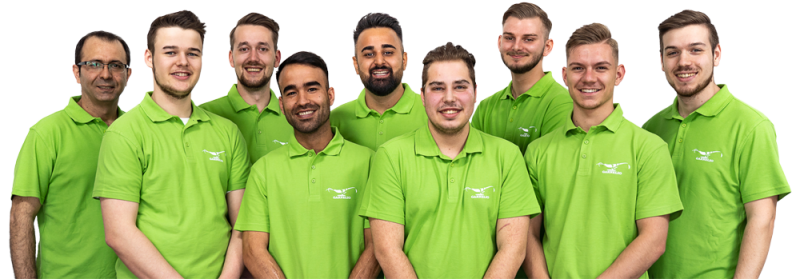
We are here for you
Whether you want to buy a shrimp aqu arium or are thinking about an aquascape, we are here to help and advise you. Design your new project with Garnelio, whether it's a wonderful blackwater aquarium, a biotope aquarium or perhaps a wabicusa. Or maybe you want to create a terrarium or a mini pond - then you can count on us.
With over 15 years of experience in aquaristics, you'll be dealing with passionate aquarists who can answer even the most unusual questions and are always on the lookout for the latest trends for you. Even if you are planning to operate an aquarium system with several tanks, you will find what you are looking for here. If you're not sure how to get started or have other concerns such as algae problems, fish diseases or stagnant plant growth, you can always look things up here and jump directly to the topic you're interested in via the table of contents.
In Part 1 of the new Garnelio aquarium guide, we look at the purchase of your aquarium and its interior and tell you what you can or should look out for.
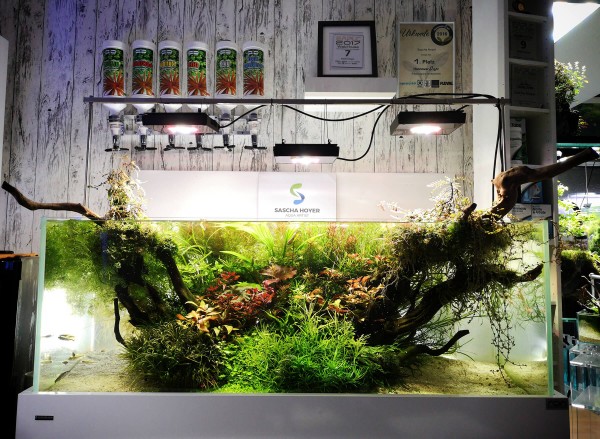
It all starts with the right aquarium!
Depending on which animals have taken your heart by storm, you should choose the right aquarium. You should also consider in advance where it should be placed, because not every location is ideal. Nano aquariums are usually small aquariums with a volume of between 10 and 54 litres. Nowadays, the selection and especially the shapes are almost infinite, so that you can find the right one for your wishes and the needs of your new co-inhabitants. In our shop, we offer you some great variants that are excellently suited for invertebrates and are also very easy to maintain.
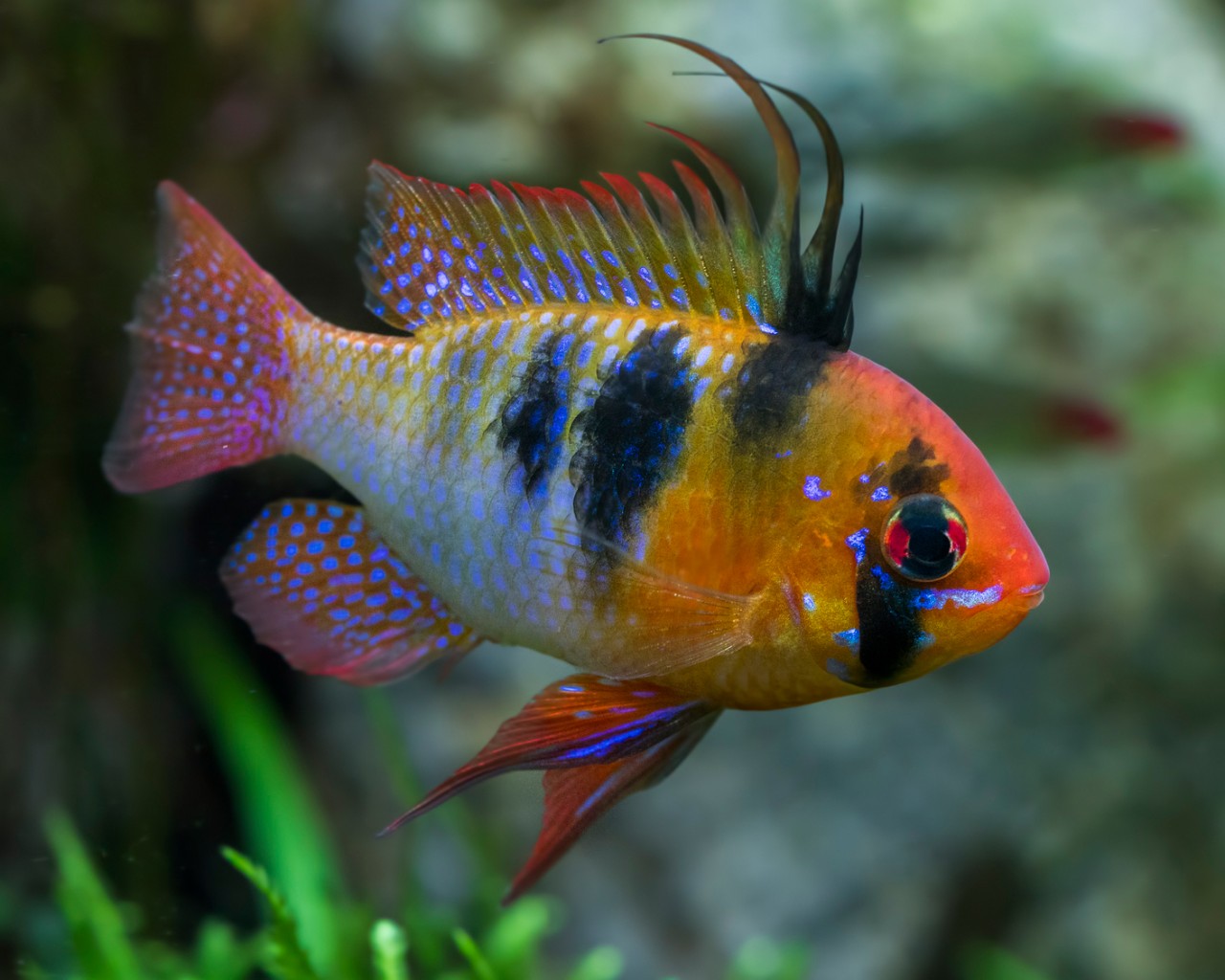
Aquarium types
Standard aquariums are mainly made of green glass and are glued black. In the age of so-called aquascaping - the artistic creation of small and dreamlike underwater landscapes - white glass aquariums with light-coloured glue are increasingly being offered. Although these are somewhat more expensive to buy, they have a noble appearance and are particularly suitable for photographing the beloved scissor knights and crawlers through the glass. The disadvantage of light-coloured bonding, however, is the formation of algae, as these can settle in the silicone seam and visually disturb the overall appearance, as they are sometimes difficult to remove without affecting the bonding.
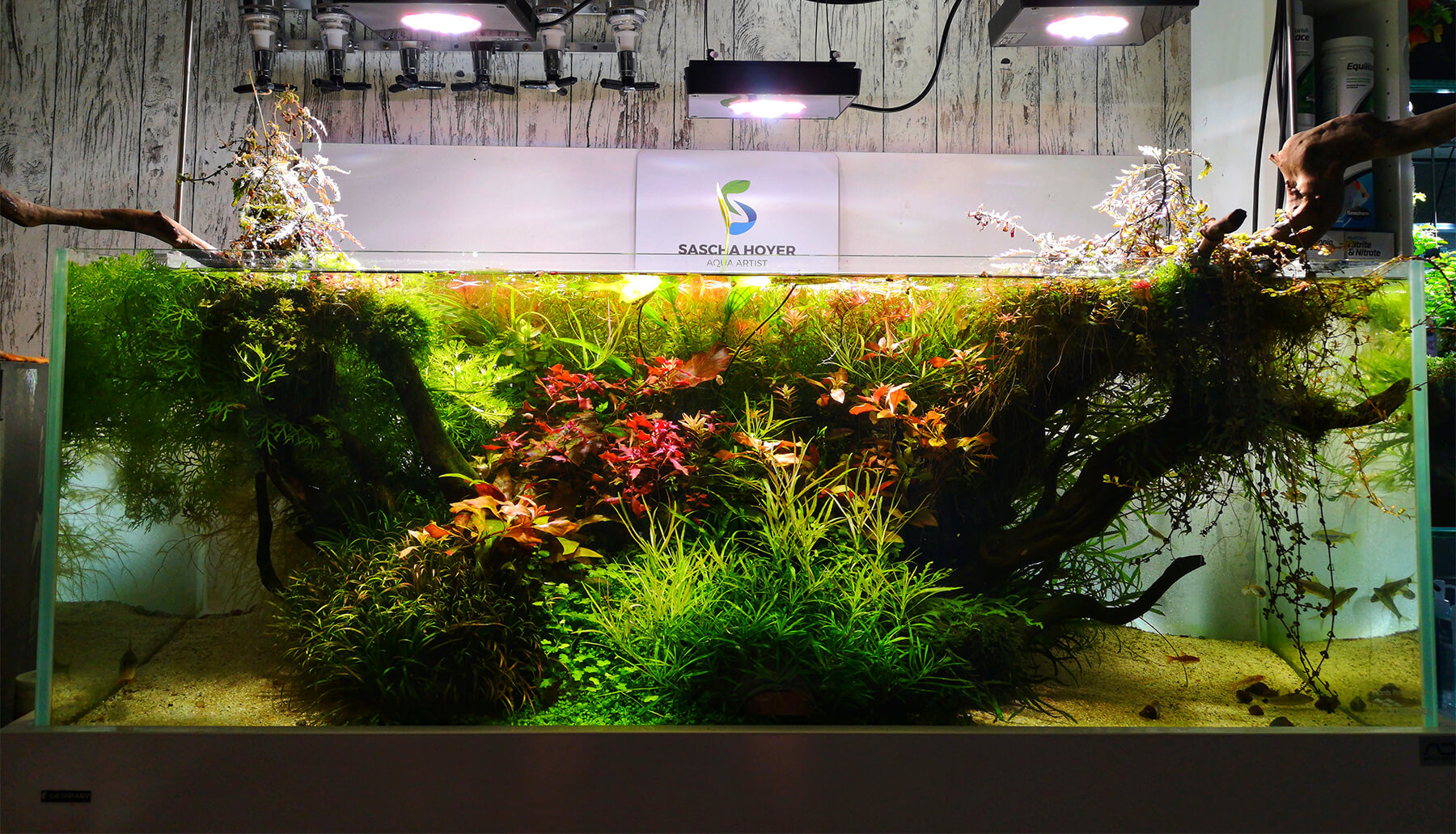
You should also consider whether you would like to maintain a so-called "pool" aquarium without a cover or whether you would prefer a closed version, either with a plastic cover, which usually already houses a light unit, or an elegant glass cover that is attached to the upper edge of the aquarium with brackets. The covered version is particularly suitable for some snail species, as they may wander off and leave the aquarium. Dwarf crayfish also tend to escape occasionally, as they are able to squeeze through cracks and can even lift light covers. With uncovered aquariums, it can also happen that shrimps or fish accidentally catapult themselves out of the aquarium during sudden jumps and land on the living room carpet. You can't always find them quickly enough to react, so unfortunately they dry up there.
The location of the aquarium should also be carefully considered, because it cannot function optimally everywhere. 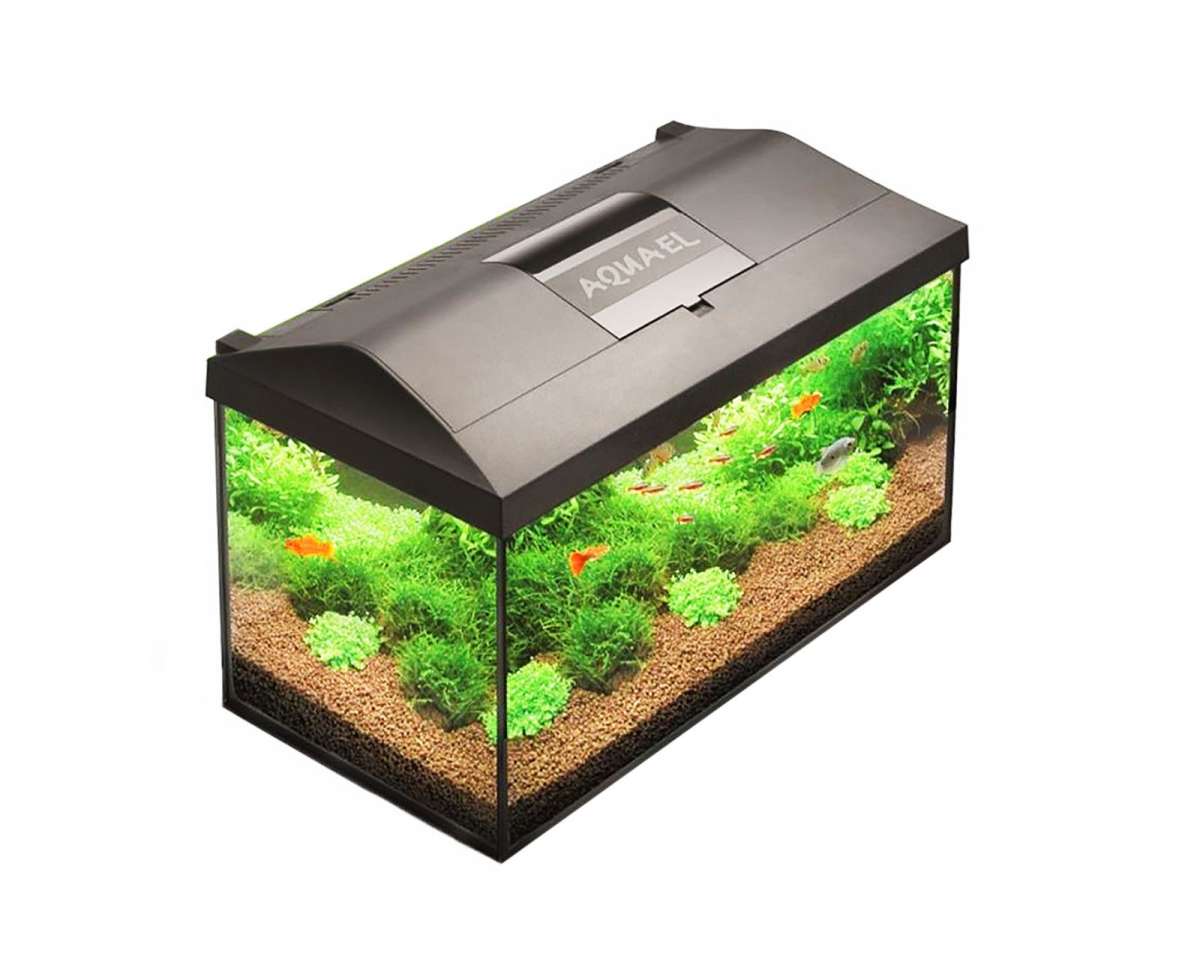
Location
Problems often occur in the aqu arium when it gets daylight or sunlight, so if possible you should choose a spot that tends not to allow this kind of "lighting". Green panes could be the result. Direct or close contact with radiators is also rather unsuitable, because the temperature in the aquarium plays an important role, which we will discuss later.
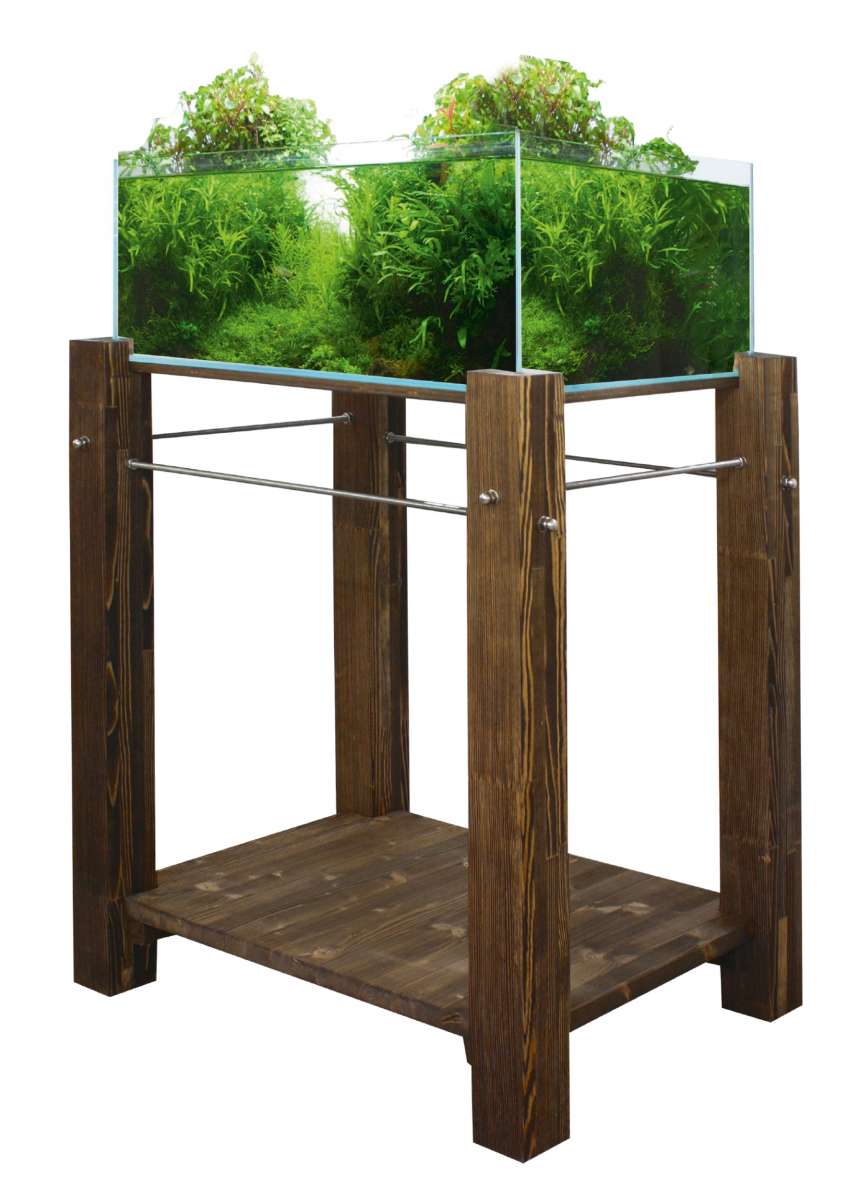
Aquarium furniture
Keep in mind that not every piece of furniture is suitable for your aquarium. From a static point of view, aquarium base cabinets are built differently than standard chests of drawers or side tables. A filled nano aquarium can weigh an astonishing amount when it is fully set up. Some pieces of furniture that are not suitable for aquariums cannot always bear this punctual load, or only for a short period of time. Your little piece of gold should also be set up absolutely straight and wobble-free. Use an underlay mat, which you can also purchase from our shop, to protect the lower base plate as well as your aquarium furniture. Before setting up the aquarium, thoroughly clean the outside of the lower glass pane and also the surface on which the aquarium is set up. Place the mat and the aquarium on top of it. Even the smallest grains could cause scratches or cracks in the bottom of the glass, causing it to leak.
Even though the volume of a small aquarium may seem very small, it can cause considerable damage to the parquet floor in the event of an accident. Just imagine if you were to accidentally spill a filled cleaning bucket. Ideally, you should check in advance with your household insurance whether water damage is covered. If necessary, find out whether damage caused by leaking aquarium water is also explicitly covered, because water damage caused by a washing machine or an aquarium is sometimes covered by different insurance agencies. Usually, however, the aquarium can be additionally insured for a small amount if it is not already included in your policy.
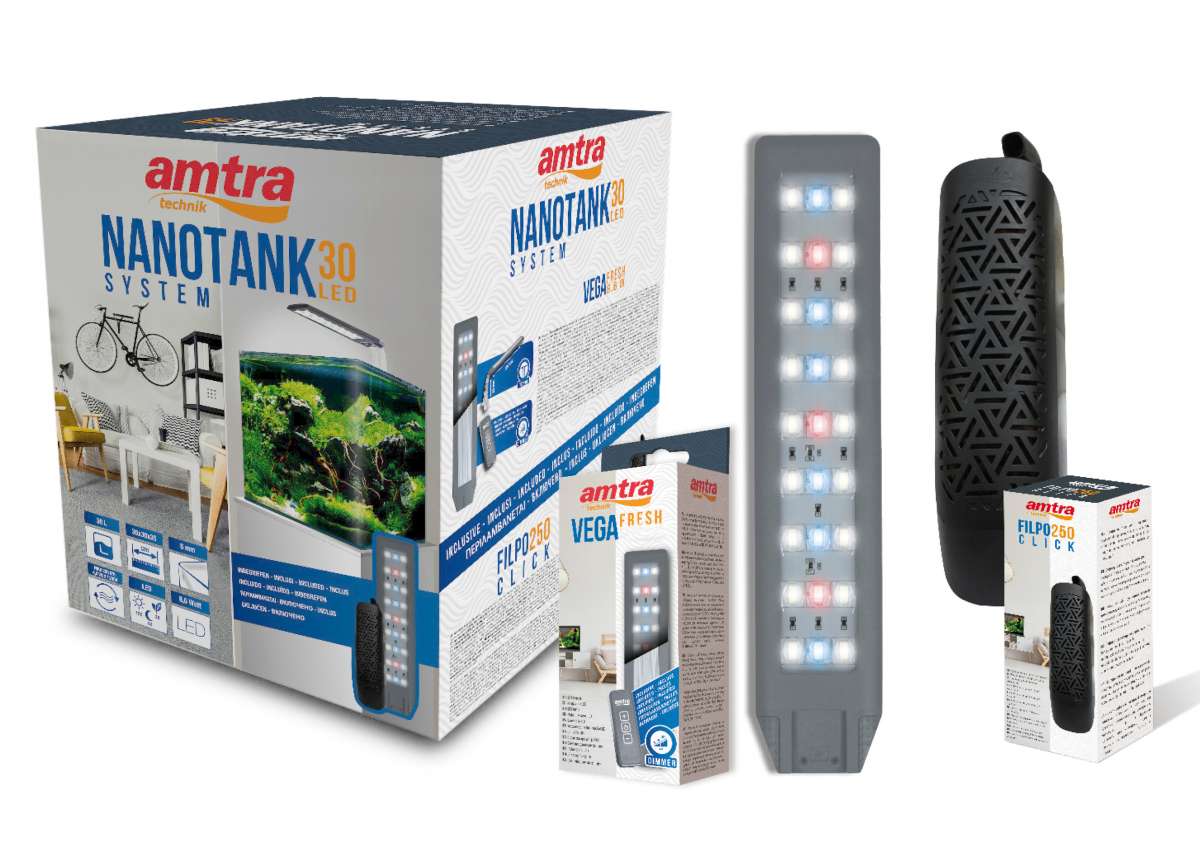
Technology in and around the aquarium
Most complete sets already include the necessary technology to operate the aquarium. This includes lighting, a filter and usually also a heater.
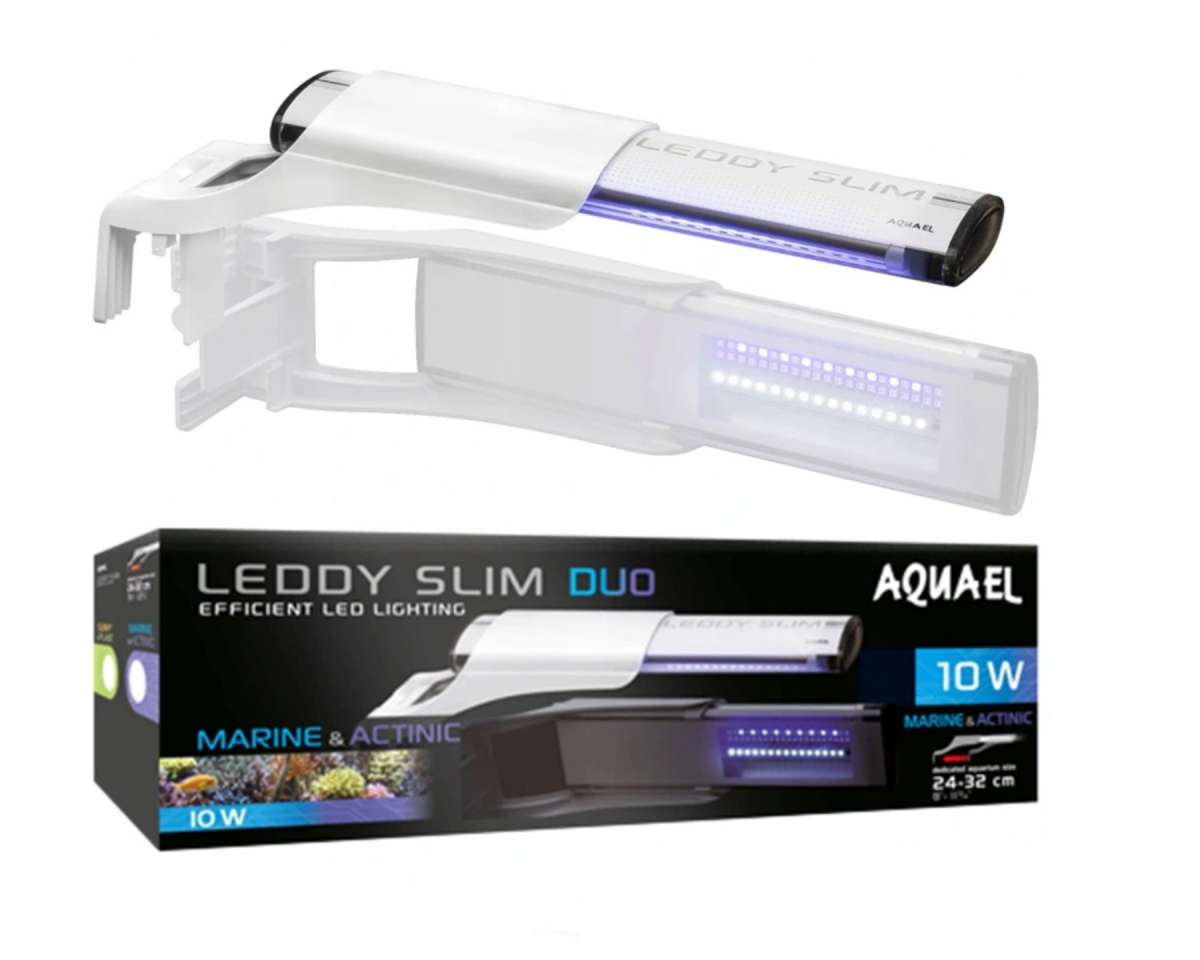
Lighting
Aquarium lighting can consist of T5 or T8 tubes integrated in the lid, but nowadays LED tubes and modules are also available, which may be a little more expensive to buy, but are more durable - because the luminosity of T5 or T8 tubes decreases after about 9 months and should be replaced, otherwise the changed light spectrum can promote algae growth in the aquarium. LEDs usually have a service life of more than 50,000 operating hours. When buying aquarium lighting, you should also make sure that it has at least an IP66, IP67, IP68 or IPX7/8 rating and that it is designed for use in an aquarium.
Depending on which animals or plants you keep, you should also pay attention to the Kelvin and lumen numbers. Kelvin refers to the physical colour temperature of a light, i.e. from cool white to warm white, depending on the number, and lumen to the luminous flux, i.e. the brightness. Aquarium lighting often has mixed modules with red, green and blue colours or even different tubes or modules in cool white and warm white.
Theoretically, brightness plays a greater role in fish keeping than in invertebrate keeping. The main purpose of the different types of aquarium lighting is to supply the plants, because only with the building block "light" can they carry out their photosynthesis, producing, among other things, vital oxygen that benefits your favourites. But some species also react sensitively to "stadium lighting" and will probably hide more often and only come out after the light has been extinguished. A good middle ground should suit both your animals and the plants. When considering lighting, also consider whether your cover glass, if you are using one, allows enough space for the integration of a top-mounted or clip-on light.
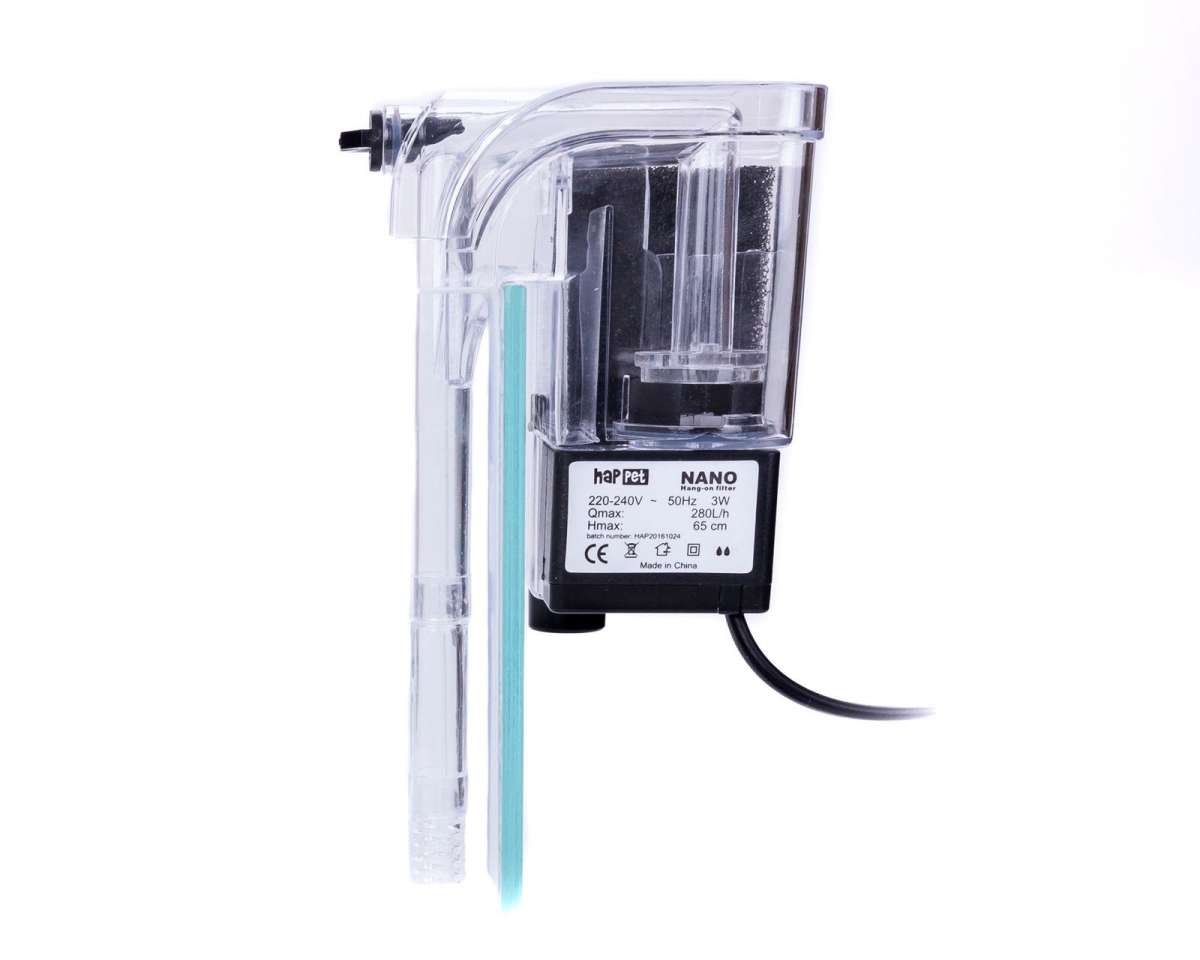
Filter - the heart of the aquarium
The aquarium filter is the heart of the aquarium. It is not only used to remove dirt, but also to break down pollutants - because inside the filter there are countless useful cleaning bacteria that convert and break down pollutants. To do this, however, the bacteria need oxygen, which in turn the filter outlet produces by returning the filtered water to the aquarium and moving the water surface in the process.
The gas exchange in the aquarium basically takes place through the surface movement of the water. The higher this movement, the more carbon is expelled from the water and at the same time it is enriched with oxygen. Particularly when operating a CO2 system, care should be taken to ensure that the filter outlet is appropriate so that the carbon dissolved in the water - the nutrient of the plants - is not completely expelled unused by increased surface movement. However, the increased water movement, especially in very hot summers and with increasing water temperatures, causes a positive oxygen enrichment of the water, which contains less oxygen the poorer it is. This is one of the reasons why you should choose a filter whose flow rate and, if necessary, direction can be adjusted.
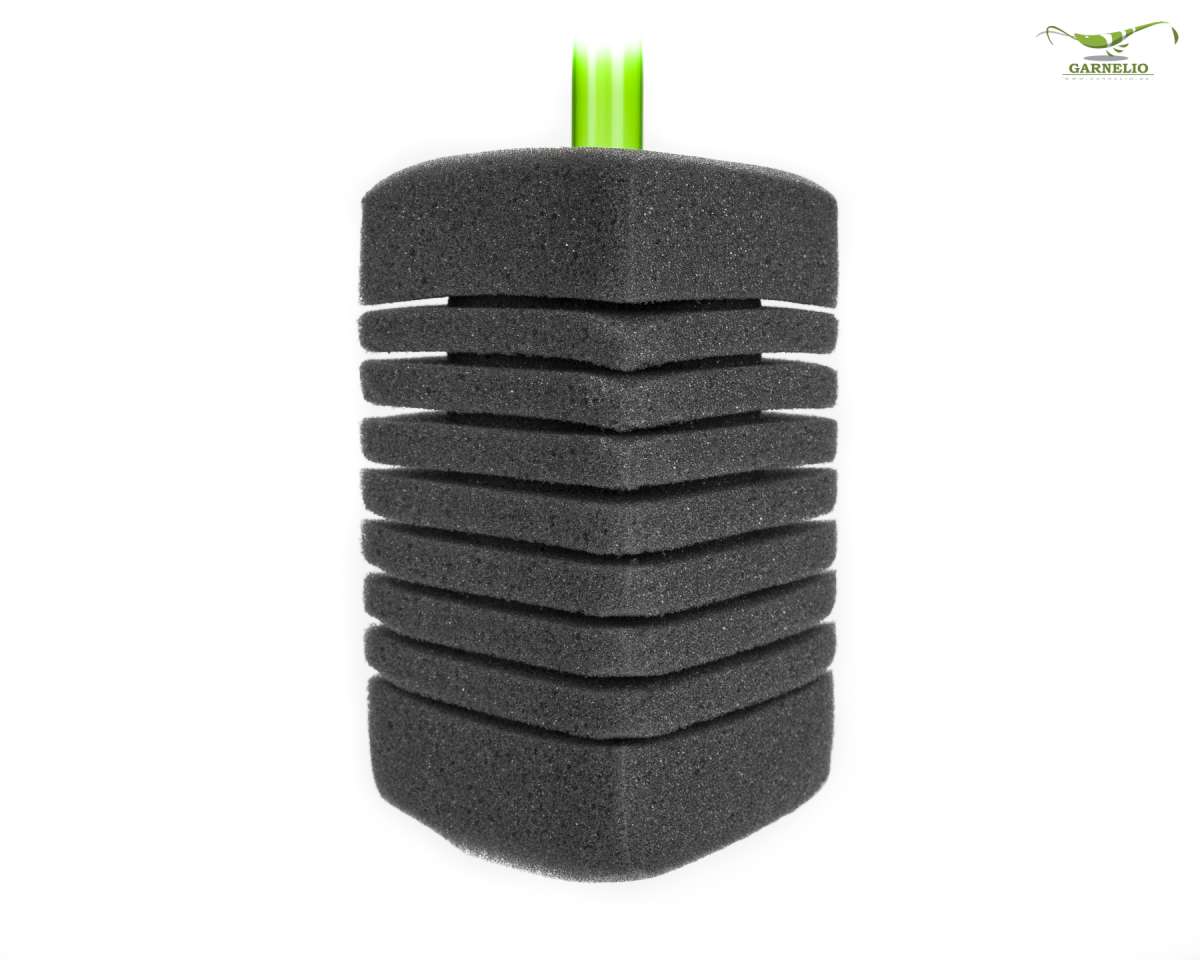
Shrimp-safe filters
Especially when keeping shrimp, you should also make sure that the suction device is very fine, so that no young animals are sucked in and transported into the filter, which they will not survive. Sponge-operated internal filters are advantageous here, such as the so-called Hamburger Mattenfilter, or HMF for short, but also very fine suction baskets that can be plugged in, such as we have in our shop, or also very fine foam cartridges. Their porosity is differentiated in the unit PPI - the higher the PPI, the finer the foam cartridge, which is why PPI 45 is ideal for shrimp breeding. With coarser sponge filters, there is a risk of juveniles hiding in the fine pores to moult and getting caught in them.
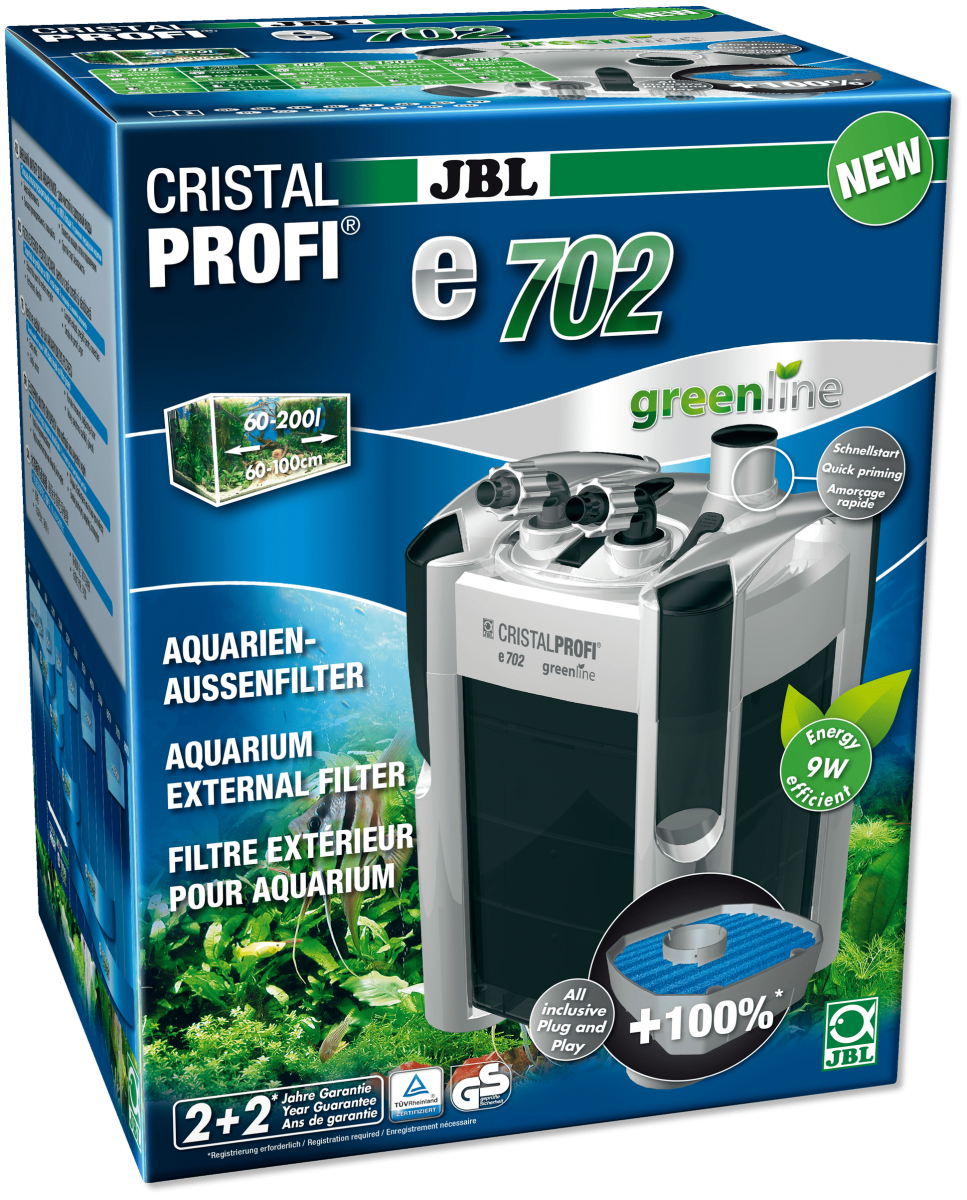
Internal vs. external filter
Aquarium filters also come in different formats. Complete sets mainly contain internal filters, which, as the name suggests, are located inside the aquarium and are attached to an aquarium pane. In addition, there are external filters, which are located outside the aquarium and are connected to two hoses, which on one side attract the water and guide it out of the aquarium through the filter, from which it is released back into the aquarium on the other side. Especially in aquascaping, external filters are often used in combination with glass filter outlets and suction baskets - the so-called Lily PipesGlass Popy Pipe, Spin Pipe or Inflow Pipes. Visually, these add excellent value to such a scape, as they make the filter technology look discreet and very elegant. Another advantage of external filters is that they can be maintained and cleaned without disturbing the aquarium inhabitants. In addition, a heating unit can be integrated into some external filters, which does not take up any space in the aquarium or would be visually or technically disturbing there. External filters can also be practically filled from the outside with filter media from the outside.
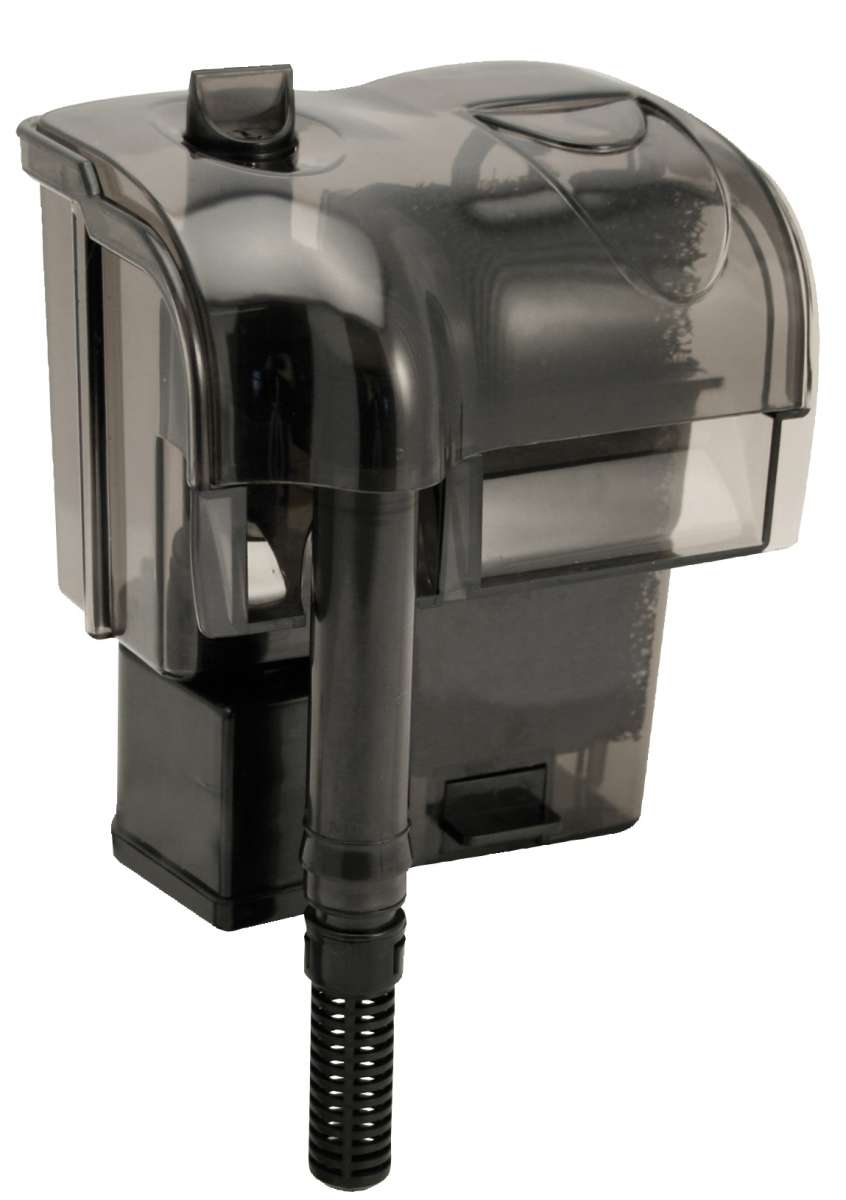
Backpack filter to hang on
Another variant are backpack filterswhich are placed on the edge of an aquarium pane, with the filter unit outside the water. These can also be cleaned and maintained from the outside without the aquarium inhabitants noticing, and the filter media can be changed in no time at all.
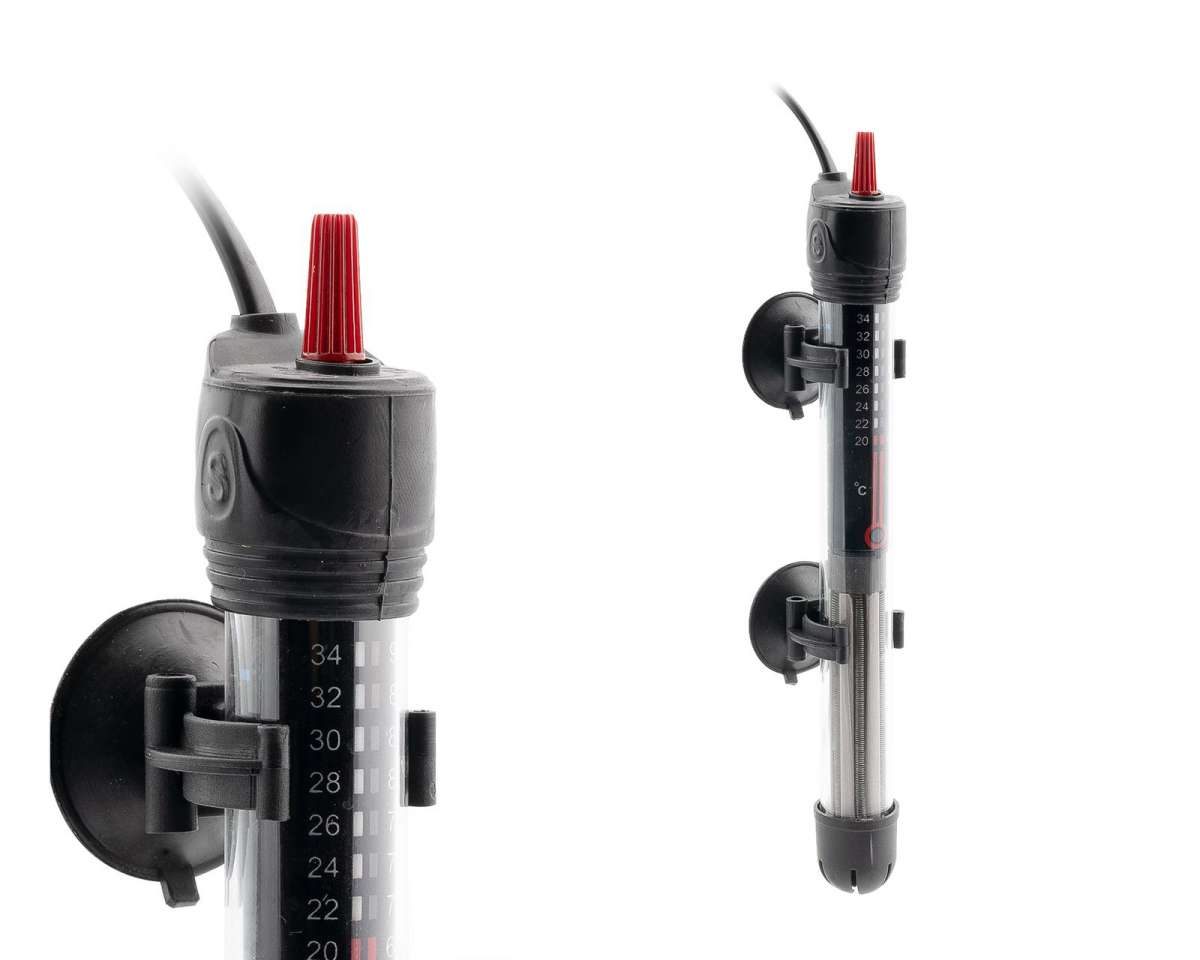
Heating and cooling in the aquarium
Most invertebrates prefer cooler temperatures. Neocaridina, for example, can be kept between 5-30°C, Caridina at 15-25°C, dwarf crayfish at 20-26°C and snails at 4-30°C. Mainly fish, which regulate their body temperature via the ambient temperature and usually come from more tropical climates, prefer it a little warmer, as this is the only way for their metabolism to function properly. Invertebrates, on the other hand, can be kept almost at room temperature, but especially in summer their water temperature should be well monitored and rather cooled down, as they do not tolerate high temperatures well.
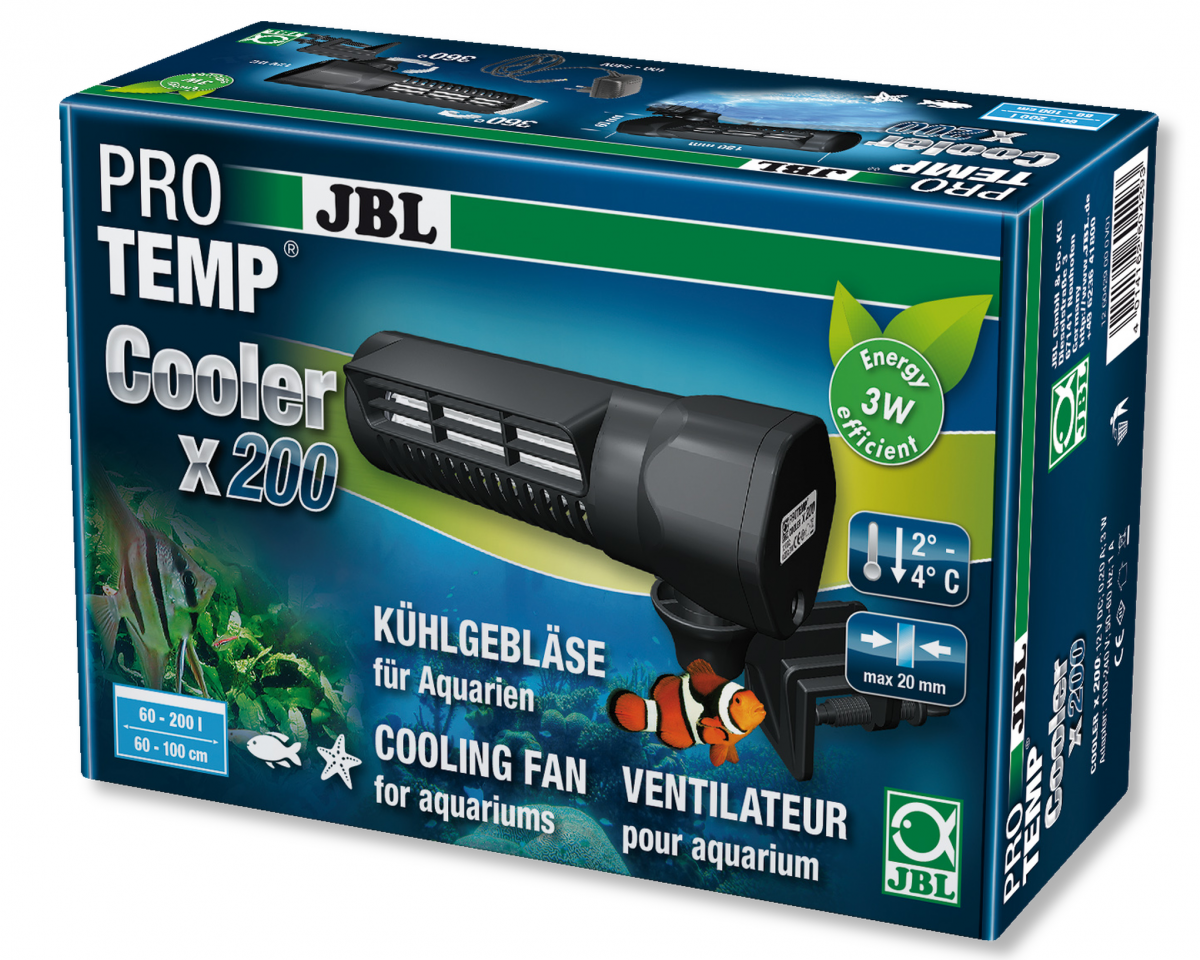
Aquarium cooling
This cooling is quite easy with an aquarium cooler, as we also offer them in our shop. These cooling fans are indispensable especially at high outdoor temperatures and lower the water temperature by 2-4 °C through the principle of evaporative cooling. The fan is simply placed on the edge of the aquarium and can be optionally equipped with a sensor, the Cool Control thermostatThe fan is simply placed on the edge of the aquarium and can optionally be connected to a sensor, the Cool Control Thermostat, so that it only starts operating when the preset temperature is reached or about to be exceeded.
This uses a simple physical process: The fans cause a stream of air to sweep over the water surface, the water evaporates and consequently condenses as evaporative cooling. The resulting water loss should be compensated for regularly. It is helpful here, for example, to mark a line with a sharpie on an inconspicuous side pane of the aquarium. Please note, however, that only H2O, i.e. pure water, evaporates, but the minerals that contribute to the hardness remain in the aquarium, which is why this evaporation increases the degree of hardness in the aquarium. Therefore, only refill the evaporated water with pure (soft) water, for example osmosis or distilled water, as the hardness in the tank would increase considerably with tap water, especially if you have to refill the aquarium more frequently in very hot summers.
Aquarium heater
Also a heating element can also help to maintain a constant temperature in the aquarium, usually most models are adjustable. There are models made of plastic, but also of glass, which usually have a protective basket at the end of the rod to prevent it from being scratched by gravel, but also to prevent animals resting underneath from getting burnt. In order for the control heater to perform accurately, it should be cleaned of debris from time to time. Suction cups are used to attach the heater to an aquarium's inner pane; a fully submersible model can also be placed in the external filter, as already mentioned, so that no technical equipment clouds the view into the aquarium or takes up space.
When choosing a so-called control heater, you should, if possible, choose a size that is designed for an aquarium that has a higher volume than yours. The reason in this recommendation is simple: even if the initial cost differs marginally, the more powerful control heater will consume less energy and thus have a longer life. The way the heater works is simple: once set, it only starts heating when the water temperature falls below the preset temperature and only heats up until this temperature is reached again. A larger model only requires 80% power, whereas a "suitable" heater is in operation almost permanently at 100% and thus has a rather shortened life span and also consumes more energy.
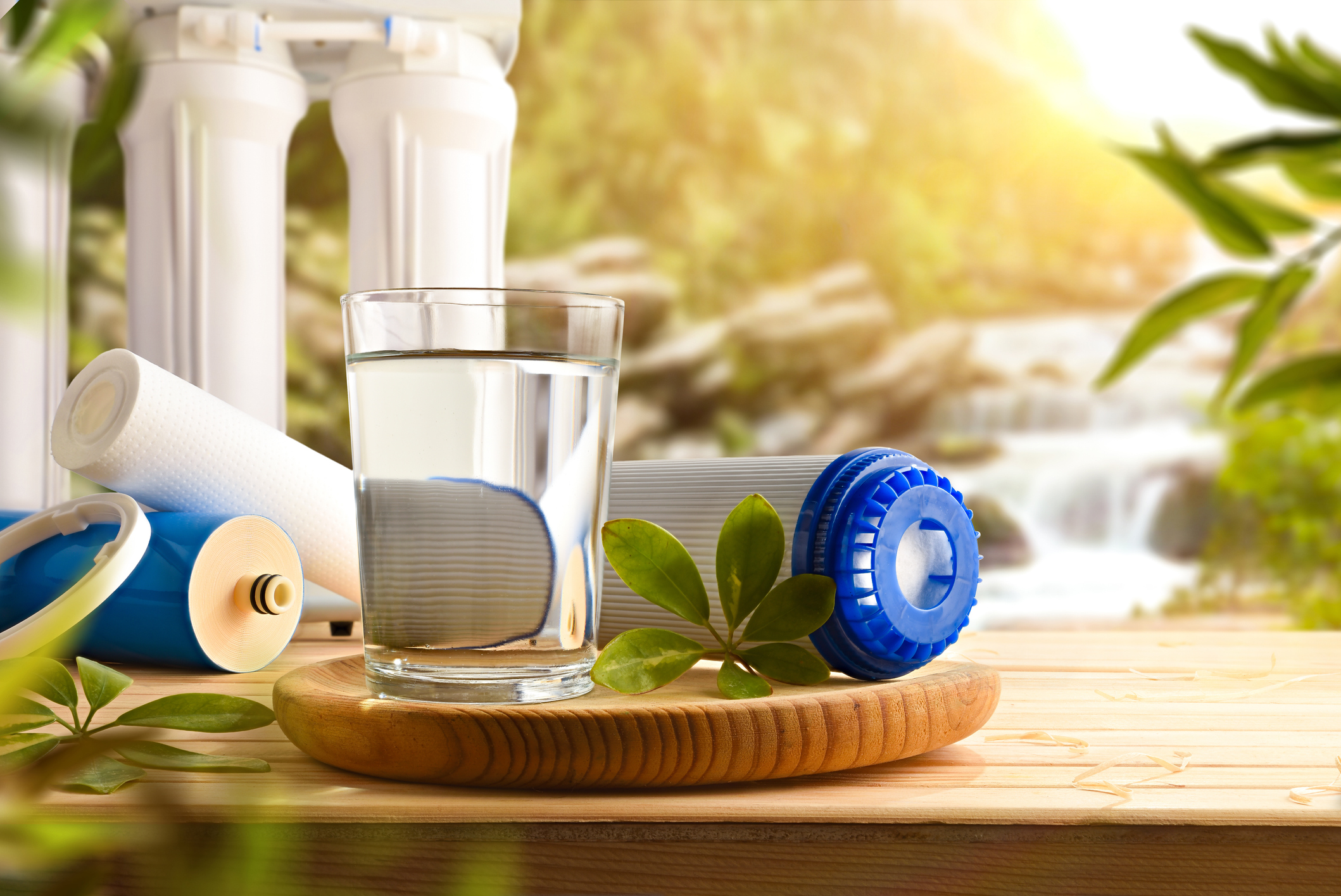
Water treatment with an osmosis system
Other useful technical equipment includes an osmosis system and a conductivity meter, especially if you make your own aquarium water with osmosis water and a treatment salt to keep invertebrates in soft water or if your tap water is not suitable for use in the aquarium because of its ingredients. Species in soft-water aquariums mainly include shrimps of the genus Caridina, but special species such as Sulawesi shrimps should preferably have a similar salt concentration as in your habitat, Lake Sulawesi, so that they feel comfortable and thrive; a saltwater aquarium should also preferably not be operated with tap water.
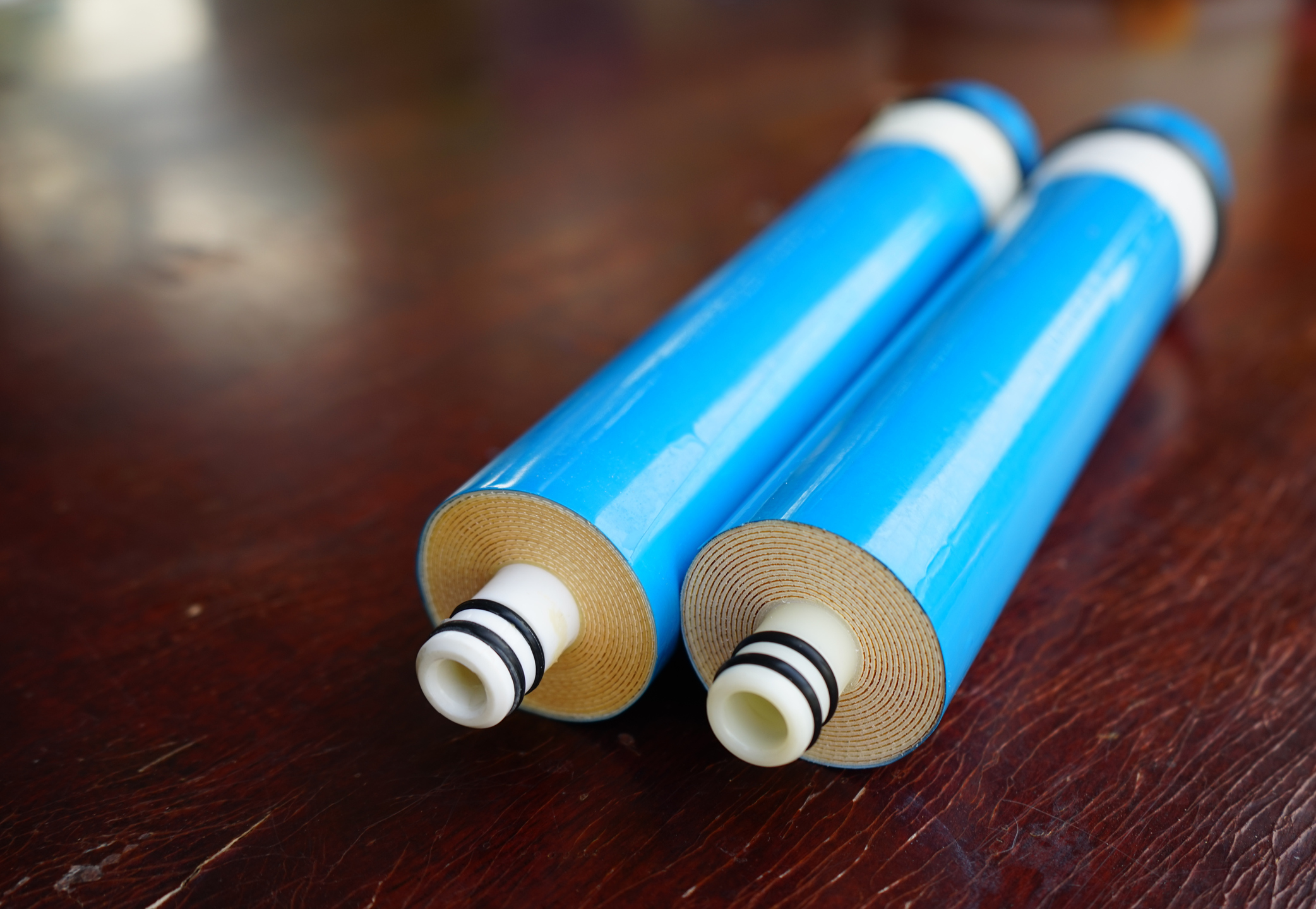
Conductivity and microsiemens
Conductivity refers to the number of dissolved cations and anions - i.e. dissolved mineral salts- in the water and is expressed in microsiemens: the lower a conductivity value is in microsiemens, the softer the water. With an osmosis system it is possible to demineralise tap water, i.e. to remove hardness constituents, but also to retain heavy metal residues such as copper, which can be found in older water pipes in particular, and which can be fatal for all invertebrates even in low concentrations. Nowadays, lead is almost non-existent in water, but it is also filtered out.
Tap water is disinfected to make it safe for human consumption - depending on the season and region, chlorine, but also phosphorus and other disinfectants are used. This is one of the reasons why aquariums require a more or less long run-in period and appropriate water conditioner Tap water is virtually free of germs and bacteria, but aquarium water is "alive" and needs a certain period of time for useful bacteria to settle, which, among other things, help to break down pollutants, but are also readily eaten by invertebrates.
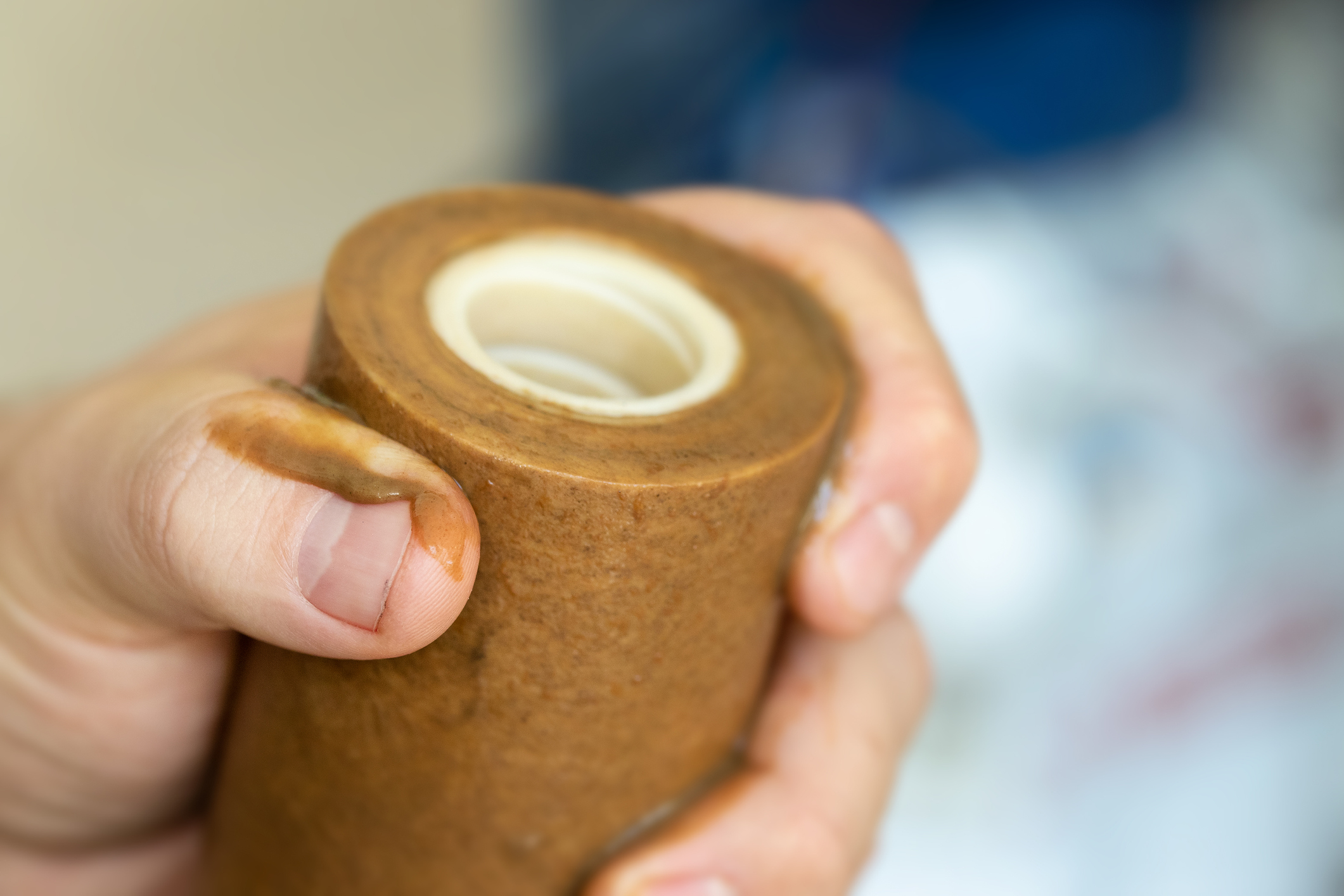
Pollutant removal through reverse osmosis
Depending on the design, an osmosis system filters out up to 98% of pollutants, but also of medication residues, which, by the way, can also be found in tap water. There is also the option of installing various additional filter units on an osmosis system, because some substances are not necessarily removed. Silicates in particular can pass through the membrane of the osmosis system and are often the reason for inexplicable algae or other problems in the aquarium - a silicate test can provide information about this, although this phenomenon only exists in certain areas and mainly causes discrepancies in saltwater aquariums, although the silicate problem has also been occurring increasingly in freshwater aquariums for some years.
In 2019, a new type of ultra-pure water filter was also introduced that is capable of removing glyphosate, a herbicide that is now also found in groundwater. This insecticide can have a negative impact on the health of invertebrates, as it is used for precisely this purpose in agriculture. So-called empty cartridges can also be connected to the osmosis system, which can be equipped with filter media of your choice, indicating by a colour change that these should be better regenerated or replaced.
How an osmosis system works
Osmosis is the process by which liquids try to equalise their concentrations by diffusion. So if you press two differently concentrated liquids through a semi-permeable membrane, i.e. a membrane that only allows water molecules to pass through, the water flows from the more low-concentration side to the more-concentrated side. Tap water pressure reverses this principle, which is why it is called "reverseosmosis". The pressure of the tap water presses the water molecules through a plastic membrane, whose residual water then contains the remaining ingredients such as hardness constituents, pollutants, but also other molecules, as mentioned at the beginning. The pure term "osmosis" has derived from this and is catchily known in the aquarium hobby. The "osmosis water" that has now been created must be re-mineralised for use in the aquarium according to the needs of the animals being kept. It can be prepared for invertebrates in soft water aquariums, or depending on its origin, such as from Lake Sulawesi, but also just as well for hard water aquariums, but especially for marine aquariums.
The advantage of this treatment is the removal of pollutants from the aquarium and an almost constant adjustment of the required hardness levels, which would not be possible with tap water, which changes in some cases. The membranes of the osmosis system should be replaced from time to time. Just like the constant monitoring of the water values in your aquarium, you should also check the osmosis water from time to time - because this provides information about an imminent replacement when the conductivity or hardness levels increase.
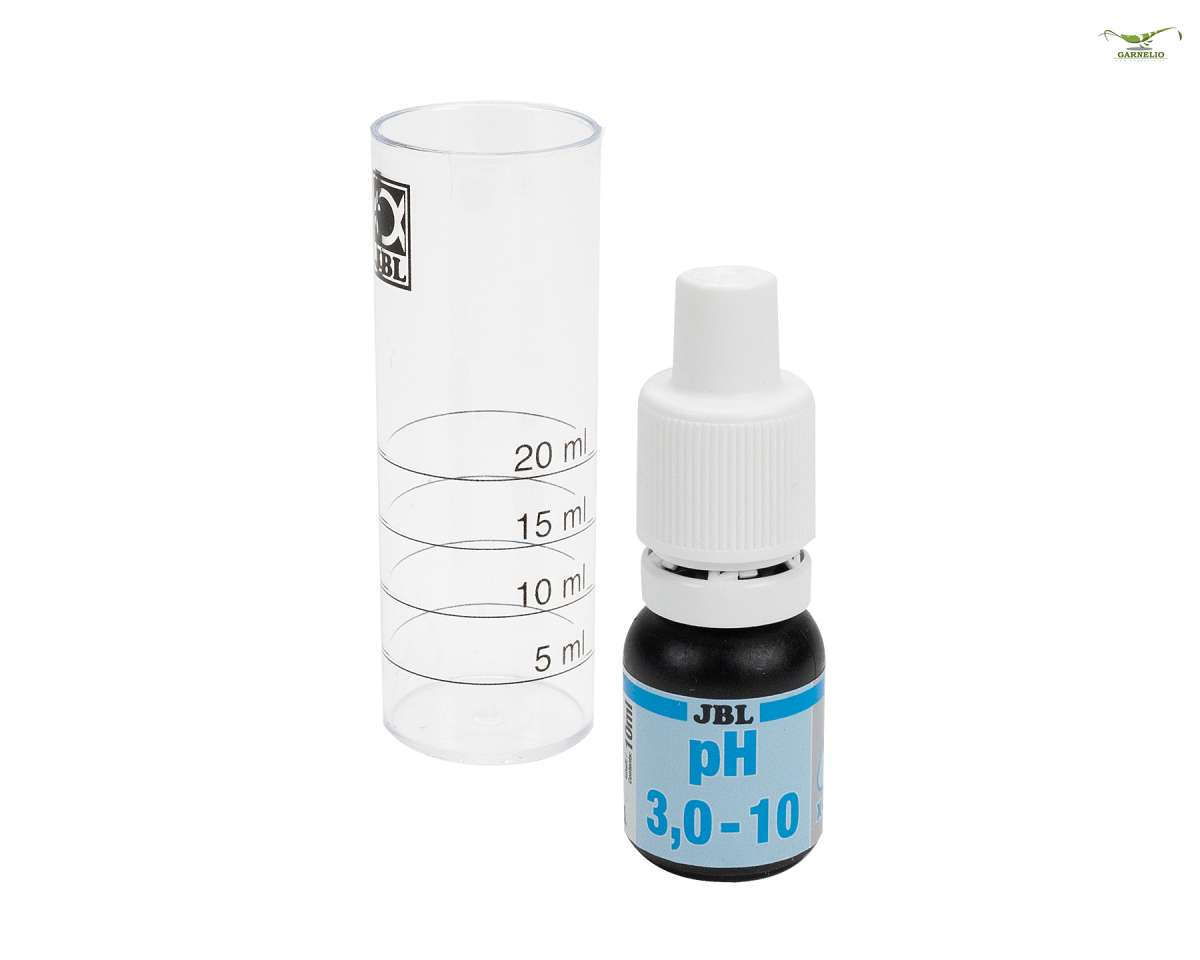
pH-value meter
A pH-value meter can also be advantageous, especially with high-breeding shrimp, in order to correctly determine the pH-value of the water and adjust it if necessary. However, we will go into more detail about this water value in the chapter "Water chemistry".
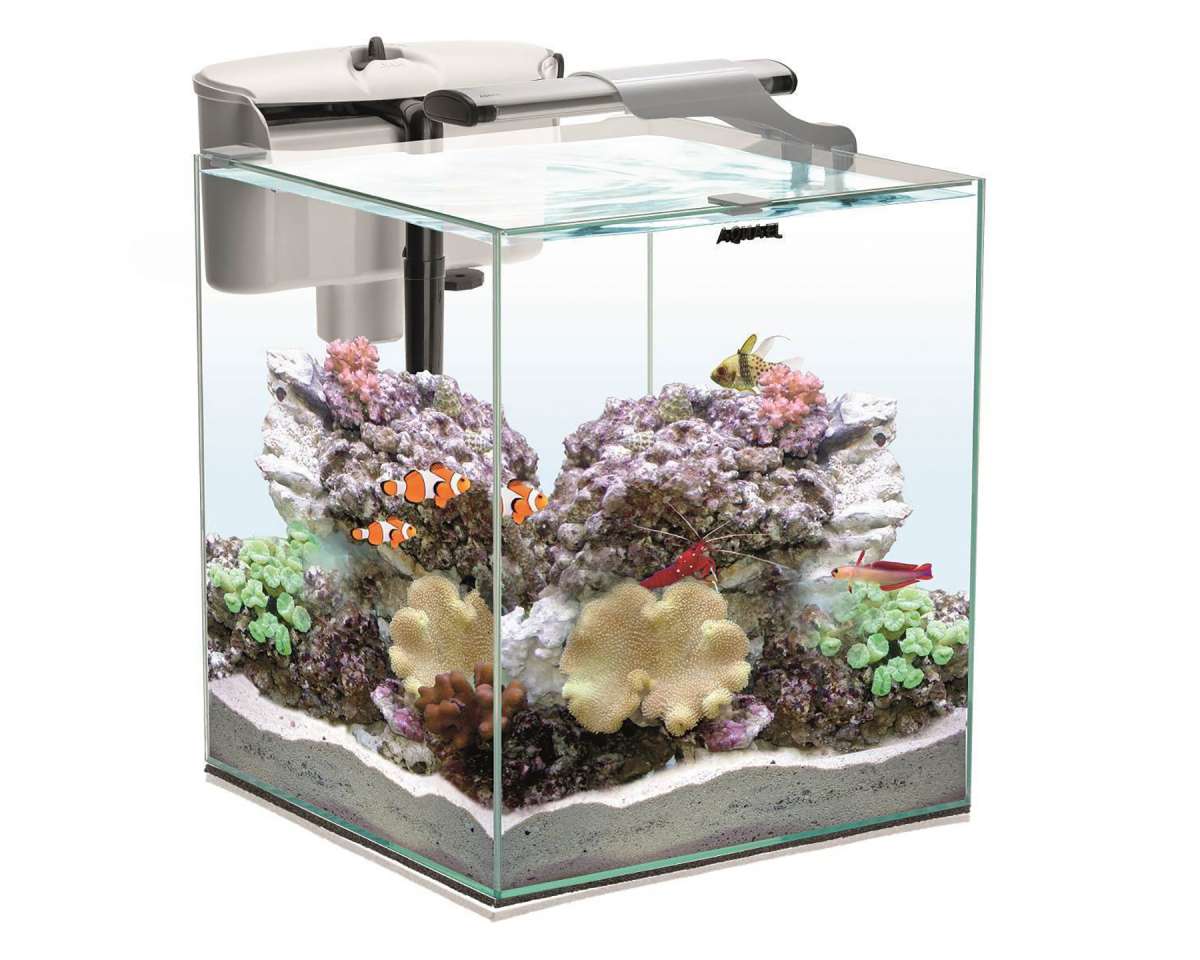
Technical equipment in a saltwater aquarium
If you maintain a saltwater nano aquarium, a refractometer that determines the density of the water is definitely recommended. A simple hydrometer serves roughly the same purpose, but is not necessarily reliable and relies on a measuring temperature. In addition, these break quite easily and are often more complicated to handle. Even if a digital refractometer is somewhat more expensive to purchase, it rewards you with accurate measurement results so that the aquarium water can be optimally adapted to the needs of your fosterlings - and you should only make a few compromises on this point - bear in mind that almost all marine invertebrates that you find in the trade actually originate from the sea, as artificial breeding cannot yet be carried out so effectively at the present time to meet the demand.
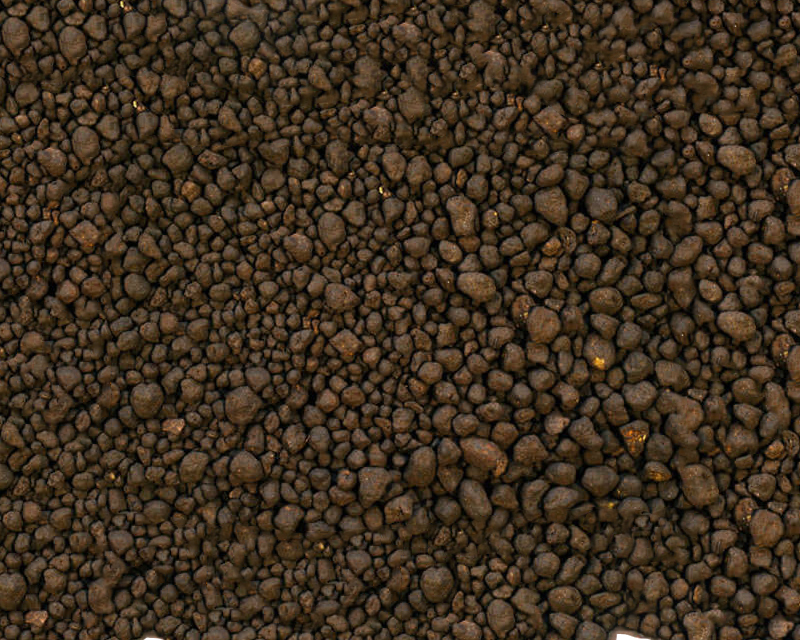
Substrate and culture medium - differences and selection
At first glance, choosing the right substrate looks more difficult than it really is. Depending on which animals are the focus or which "outfit" the aquarium is to have later on, a few things should be considered. Especially if, for example, it is to be a beautifully sculpted soft water aquarium with dwarf shrimps of the genus Caridina.
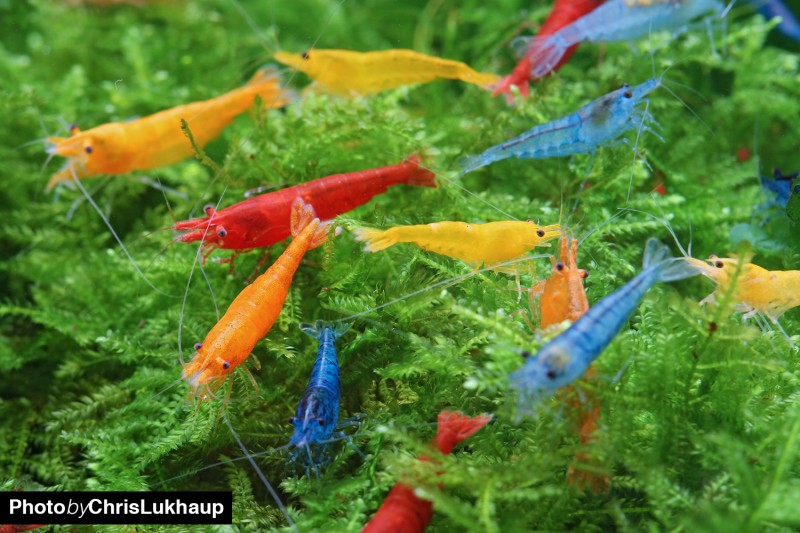
The task of the substrate
Substrates are literally a dime a dozen - and sand is indeed one of the most natural materials you can use in an aquarium. Our many years of aquarium experience recommend that you use natural materials when designing your aquarium, as these not only greatly enhance the well-being of the animals you keep, but also promote plant growth and cause fewer problems. Last but not least, you create a natural look, because your aquarium is basically nothing more than a section of a certain habitat.
In addition, the substrate performs a variety of tasks in the aquarium. Especially in it, countless useful cleaning bacteria are formed, which actively participate in the breakdown of pollutants in the aquarium and, among other things, are readily eaten by invertebrates, so it already serves as a "filter", so to speak. It also supports plant growth by releasing nutrients. When buying substrate, make sure that it is suitable for aquariums. Pebbles or play box sands from the DIY store are rather unsuitable, as they are often mixed with various chemicals and also do not have rounded grains. Ideally, the substrate you choose should be rounded - because your animals might injure themselves on sharp-edged grains - especially if you keep a community aquarium with bottom-dwelling fish.
Here we go into a few possibilities.
Bottom heating
The installation of a bottom heating system in the form of a cable is another consideration that you should make before adding substrate, as the entire aquarium would have to be disassembled afterwards.
Bottom heating on the aquarium floor serves primarily to provide thermal circulation of the water, which in turn has a positive effect on the root formation of aquarium plants. This is because aquatic plants in their natural habitat generally grow better when nutrient seepage sources are available to them, because it is from these that they obtain their nourishment; the nutrients they need to grow. A bottom heater simulates this effect, because it becomes slightly warm. This causes the heated water to rise and exchange with the colder water, which sinks to the bottom packed with nutrients. These nutrients and minerals are washed directly to the plant roots, which in turn can absorb them better and grow more vigorously.
Laying the underfloor heating cable is not really that complicated in and of itself: the silicone-coated heating cable is fixed to the ground in a spiral with slotted suction cups and then covered with the other soil layers.
Tip
Keep in mind that a bottom heating cable can never replace a control heater in the aquarium, as it cannot heat the aquarium water to the required temperature of a warm water aquarium!
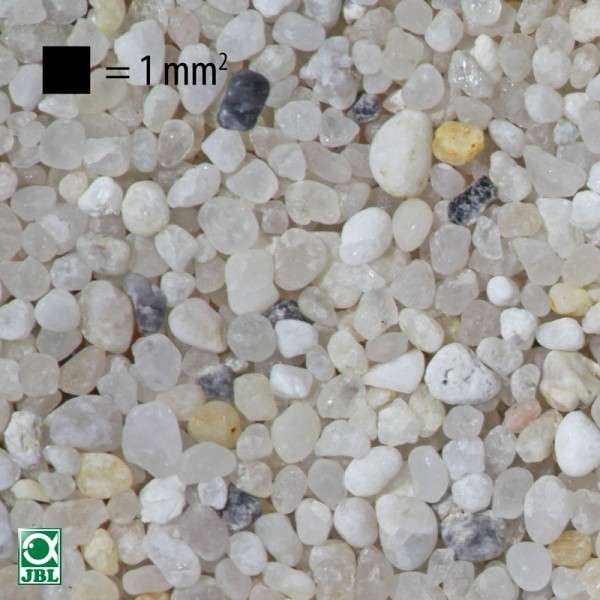
Sand
Sand or "very fine/ fine gravel" is defined as sand up to a grain size of 2 mm, so you should always consider the grain size when choosing.
Although sand is one of the most natural substrates, coarser gravel between 0.5 and 2 mm is more suitable for invertebrates such as dwarf crabs or shrimps, as the animals can lift and turn it over with their claws and look for food among the small stones.
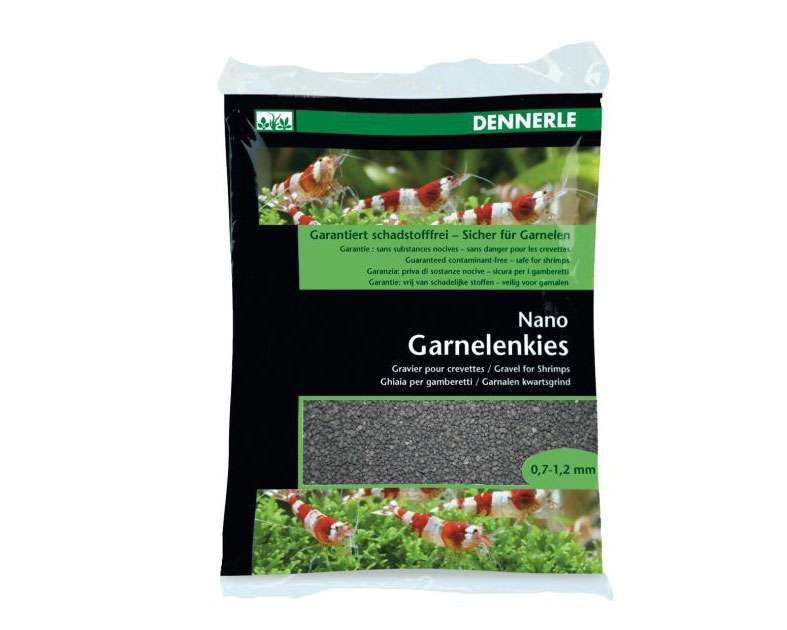
Gravel
Gravel, or quartz gravel, is usually defined as gravel with a grain size larger than 2 mm.
Coloured gravels in rainbow colours are certainly nice to look at, but keep in mind that these gravels do not occur so colourfully in nature. Most of these gravels are plastic-coated or otherwise coloured, which is why they cannot or should not be washed out hot before use, as they run the risk of detaching undesirable substances that then end up in the aquarium.
It is therefore better to use natural gravel such as quartz gravel or other gravel that does not harden. Specially hardening gravels are mainly needed in marine aquariums, for brackish water animals, but also for cichlids and are not necessary for invertebrates in freshwater aquariums.
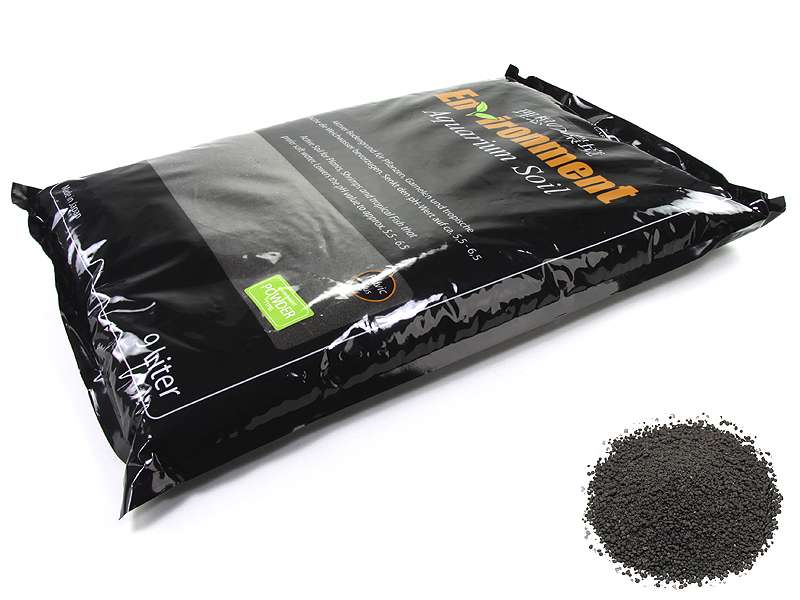
Active and mineral substrates: Soil
Are you always amazed by wonderfully furnished scapes with their incredible plant diversity and magnificent animals? Then "Soil" was certainly your favourite substrate!
Although "Soil" means nothing more than "earth" or "soil", it differs significantly from all other aquarium substrates, because it is a special substrate that actively influences the water values. Especially in aquascaping, where the main focus is on the aquatic plants, pre-fertilised material is often used, whereas in the breeding and care of Caridina, specially designed Soil is preferred. In distinctly soft water aquariums, such substrates are preferred because they have a significant influence on the hardness levels, but also on the pH value in the aquarium: most of the animals kept in the aquarium, but also the aquatic plants, come from rather acidic habitats with a constantly high nutrient supply at very low total and carbonate hardnesses. Plants in particular show improved uptake and correspondingly vigorous growth at acidic pH values between 5.5-6.8.
Excursus: Soil production and ingredients
These active soils are purely natural products consisting of natural earths and are mainly mined in volcanic areas. As a result, they contain very high levels of nutrients and minerals, but also humic and other acids, which have a positive effect on the vitality of invertebrates in particular. Occasionally, soils are also enriched with other ingredients during the production process, such as carbon, which in turn are capable of binding unwanted substances and clarifying the aquarium water, as we are used to from filter media. Soil is usually blackish brown to dark brown, giving the aquarium a very natural appearance. In an elaborate process, the extracted soils are granulated and sometimes baked several times.
Although the granules are softer than conventional pebbles of the same grit size, it is precisely this property that makes the Soil so interesting. Above all, thanks to various grain sizes, including powder, landscapes such as elevations and hills can be designed much better with the so-called "Dry Start" (the fog-damp aquarium that is only filled with water afterwards). Moreover, not only does planting become child's play, but it also provides them with better rooting later on.
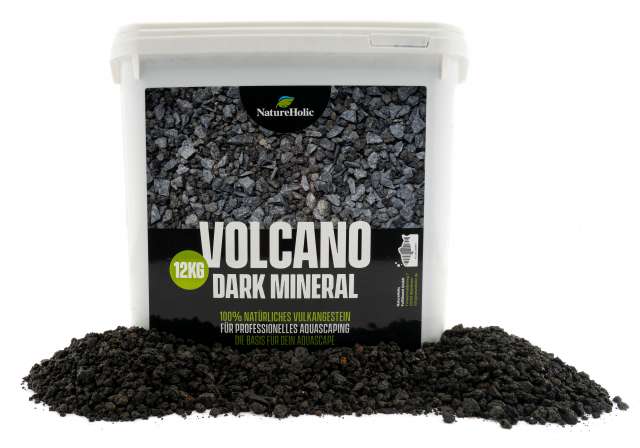
Nutrient medium in the aquarium
A nutrient medium is placed under the aquarium gravel when setting up the aquarium and is not really necessary when using Soil. A nutrient medium contains nutrients such as iron, various minerals and trace elements that are essential for plants. The clay components present in the material also act as a depot that binds excess nutrients, but can also make them available again when needed. In newly set up aquariums, a nutrient substrate makes a lot of sense, as it provides plants with an excellent supply of nutrients directly from the roots and thus helps them to grow new and strong roots more quickly. In general, you should support strong and fast plant growth in a new aquarium, as healthy aquatic plants absorb nutrients and rob annoying algae of their basis for life. They also enrich the water with vital oxygen. A nutrient substrate usually lasts between 3 and 5 years before it loses its effect. But even then it can be reactivated with soil fertilisers, which we also stock in our shop.
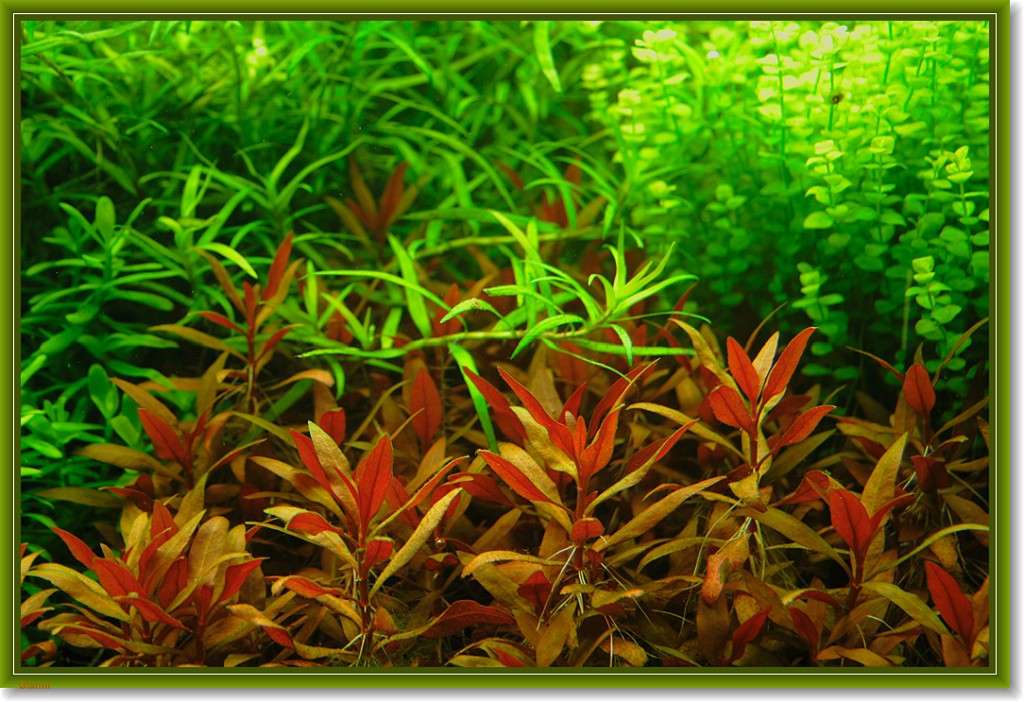
Plants in the aquarium
Plants in the aquarium do not only serve the visual appearance, they also take over several tasks that contribute to a stable system. Healthy plants grow vigorously and produce great colours. Juveniles in particular like to hide in a dense jungle of plants, especially dwarf shrimps when they are moulting and hardening their shells. Well-rooted plants have a strong stand and are not pulled out even by nimble and scurrying bottom-dwelling fish.
Did you know?
Pollutants and pathogens can be absorbed by plants, and they also feed on nutrients such as nitrate, phosphate, potassium and others, thus depriving algae in particular of their livelihood. In an aquarium stocked with fish, sufficient nutrients are usually available through feeding and the excretion of the fish, but in an aquascape, which is usually only stocked with invertebrates or not stocked at all, fertiliser should be added from time to time with a liquid fertiliser or root fertiliser.
Plants are basically dependent on various factors to enable photosynthesis. Besides good lighting, they also need a nutrient-rich substrate and a carbon source such as CO2. In addition, some plants absorb nutrients through their leaves and others through their roots. A perfect combination of all these requirements helps the plants in the aquarium to grow splendidly, healthily and colourfully, which ultimately serves all the creatures in the aquarium.
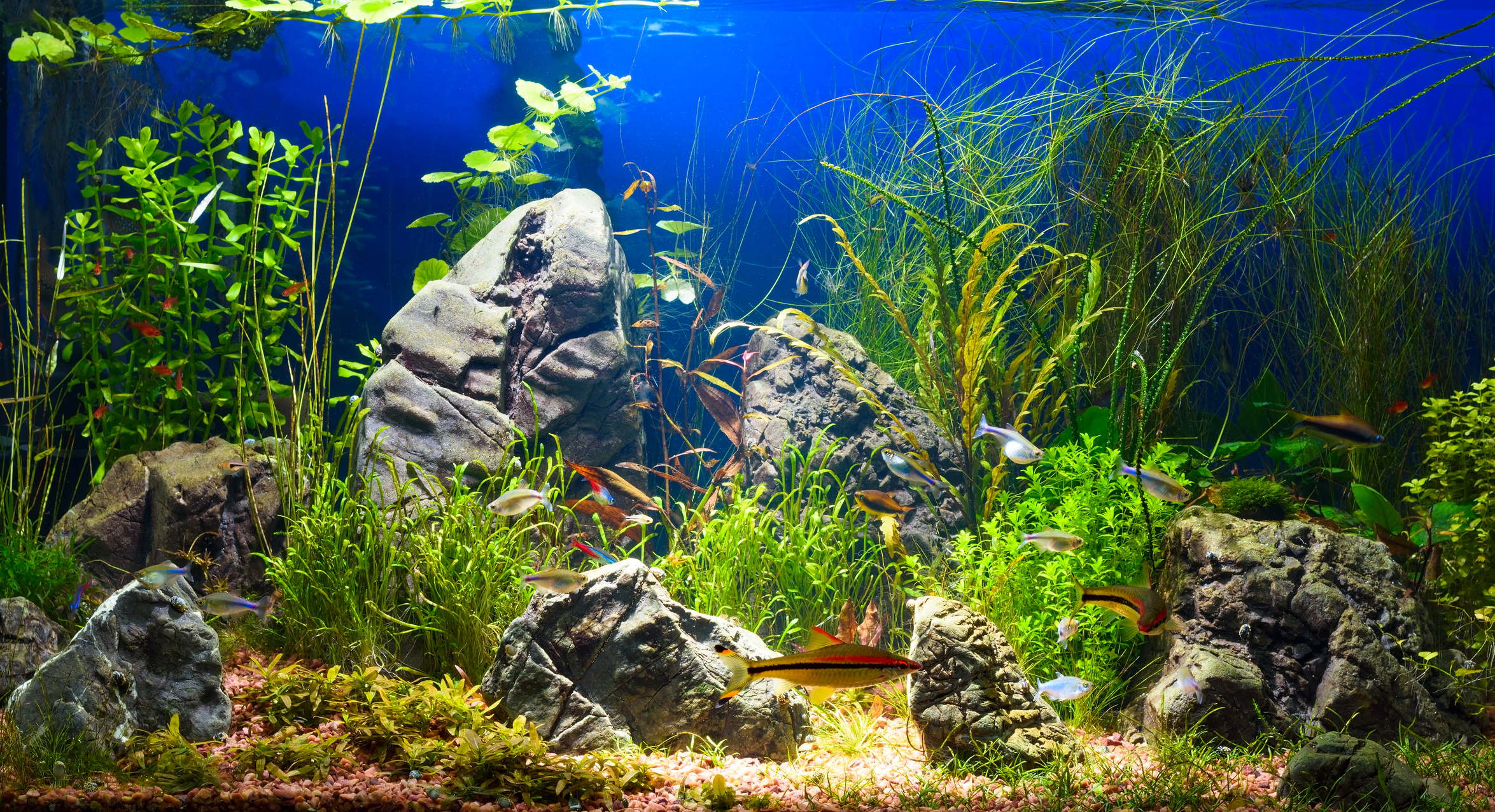
Plant species
Plants are not only divided into foreground, middle ground and background plants according to their expected final size, but also into stem plants, mosses, top plants and tuberous plants. Some of them are also offered as so-called in-vitro plants, which means that they have been cultivated under clinically pure laboratory conditions and do not bring any stowaways or pesticides with them.
Did you already know?
The vast majority of aquarium plants are not actually true aquatic plants at all, as they originally tend to occur in swampy areas and only "stand with their feet" in the water, so to speak. Almost 98% of all aquarium plants are therefore able to grow above(emers) and below water(submers). The "true aquatic plants" include, for example, Vallisneria, hornwort, waterweed, Cabomba and the tuberous plants Aponogeton and Nymphaea (lotus plants), which thrive exclusively under water.
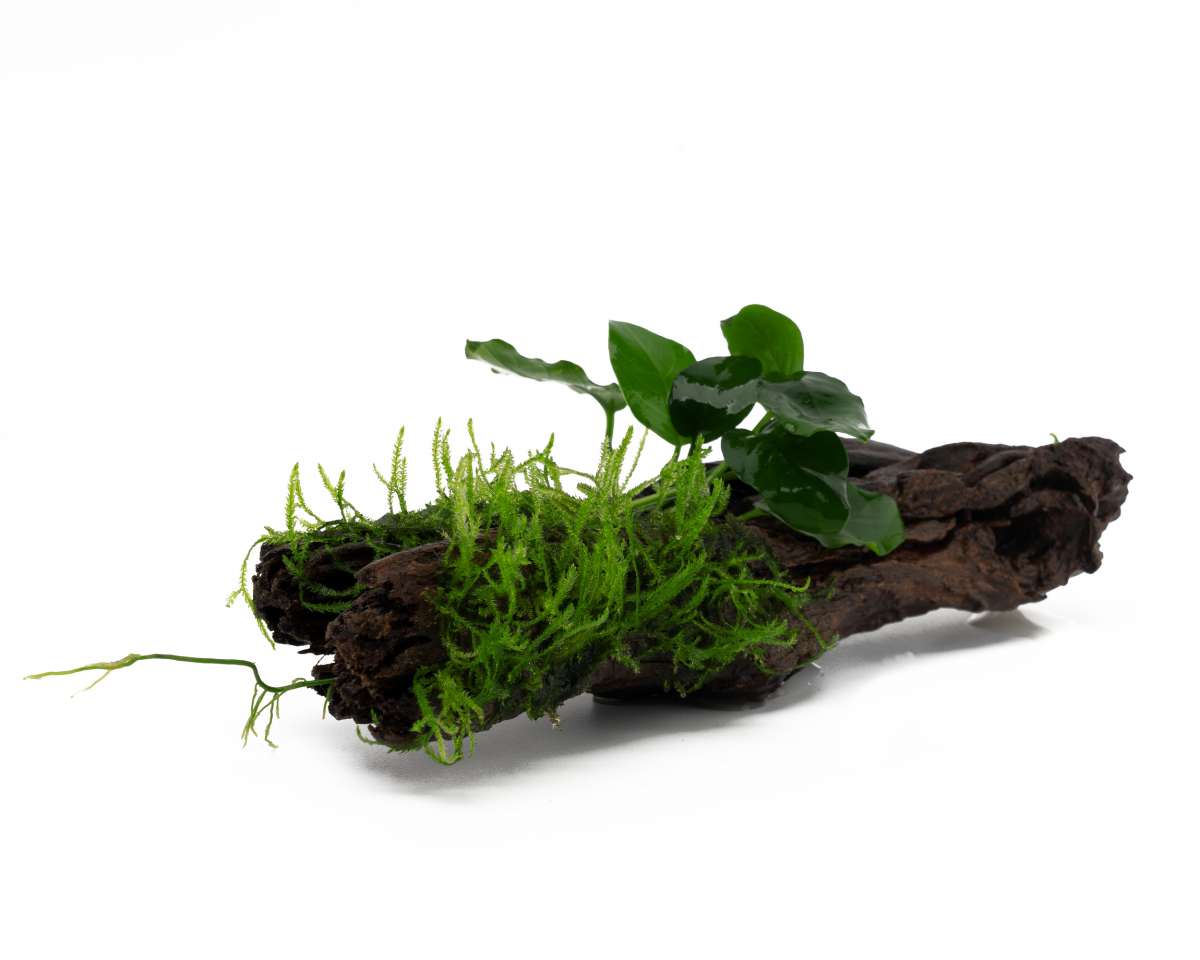
Production of aquatic plants
Aquatic plants for the aquarium are usually grown conventionally above water in aquatic plant nurseries. They then draw the necessary CO2 from the air, which has the advantage of cost-saving CO2 fertilisation. This is also the reason why most plants are grown in Asia, as these permanently warm temperatures are much more suitable for growing plants and they can therefore be produced more cheaply.
Pesticides and fertilisers
Even though it is often said that fertiliser is problematic, this is actually not the case, as most of them are suitable for shrimps. What is really problematic, however, are pesticides that are used to make the plants ready for export. But also some traditional pet shops still use "anti-snail agents", which can be fatal for invertebrates, which are also kept in the aquarium. Therefore, plants should be watered prophylactically in quarantine, as well as potted plants, fretted plants or even planted pads or stones, if they do not come from a reliable source or if it is explicitly stated that they can be used immediately in the aquarium. Sometimes the pesticides are stored in the plant tissue, so that even thorough rinsing is not sufficient. Therefore, they should be kept separately for at least two weeks before being added to an invertebrate aquarium.
Excursus: Watering plants
For bunch plants, remove the ceramic ring or lead tape, and for pot plants, remove the pot and rockwool. Just as in the aquarium, the plants need nutrients, so it is preferable to use a glass container such as a large vase, placed on the window sill, preferably out of direct sunlight, to prevent algae infestation or overheating. The UV component in daylight is conducive to pesticide degradation.
A very clean bucket and a desk lamp can also be used temporarily. During the two-week quarantine period, it is helpful to change the water completely every day, or at least a few times. A water conditioner that binds pollutants can also be used to help.
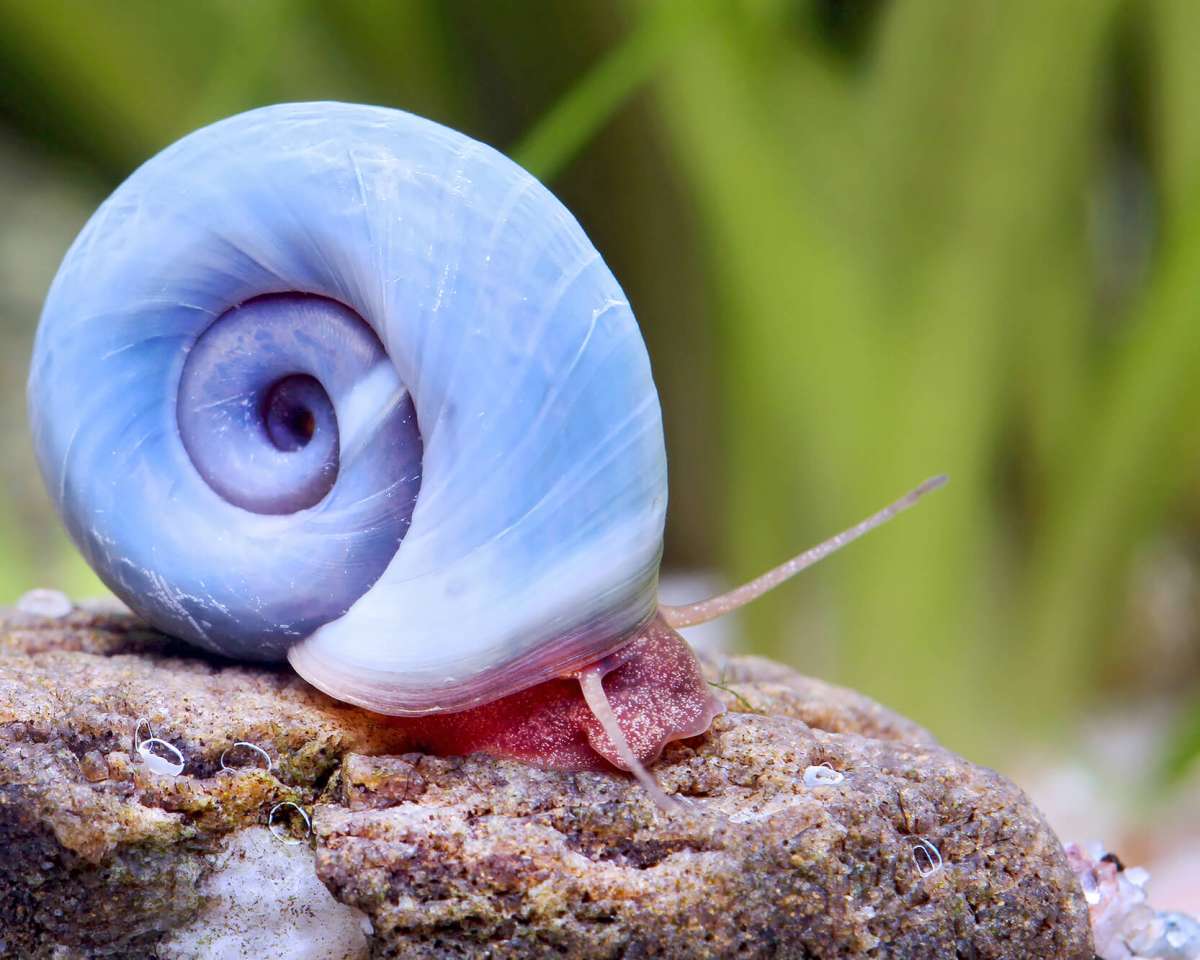
Stowaways such as snails or bubble snails can be stunned and killed by placing the plants in very bubbling mineral water for 30 seconds before they are quarantined. After the two weeks, the procedure is repeated, as snail or worm clutches are not bubbled out the first time.
To find out whether the pesticides have been removed, a test is useful: either a test shrimp or a pack of water fleas is placed in the quarantine container and observed. Problems become noticeable through uncontrolled twitching or staggering, but also falling over or jumping up and sinking to the ground - then the test shrimp should be removed immediately! If nothing of the sort happens, the plants are ready for use in the shrimp aquarium.
Prepare the plants before placing them in the aquarium
The watered plants should be as free as possible from the rockwool, as the fine fibres could well get caught in the gills of fish. The best way to remove it is under running water, but also by wiping it off or plucking it out with scaping tweezers.
In the case of very fine plants, such as the Cuba dwarf pearlwort, leave some rock wool on the fine roots, as this will function like an anchor later on and can be inserted more easily. By the way, a pair of narrow, pointed tweezers is best for inserting very fine plants, as they can sometimes be difficult to plant by hand.
Tip for inserting plants
It is advantageous to insert the plants in a group and not as a bunch, with a distance of 2 to 3 centimetres from each other, so that the plants do not take away each other's light and start to care. To do this, simply divide these stems and insert them individually. Only very large mother plants such as Echinodorus, Cryptocorynes or similar are sometimes sold as single plants, which in this case are not divided but inserted completely.
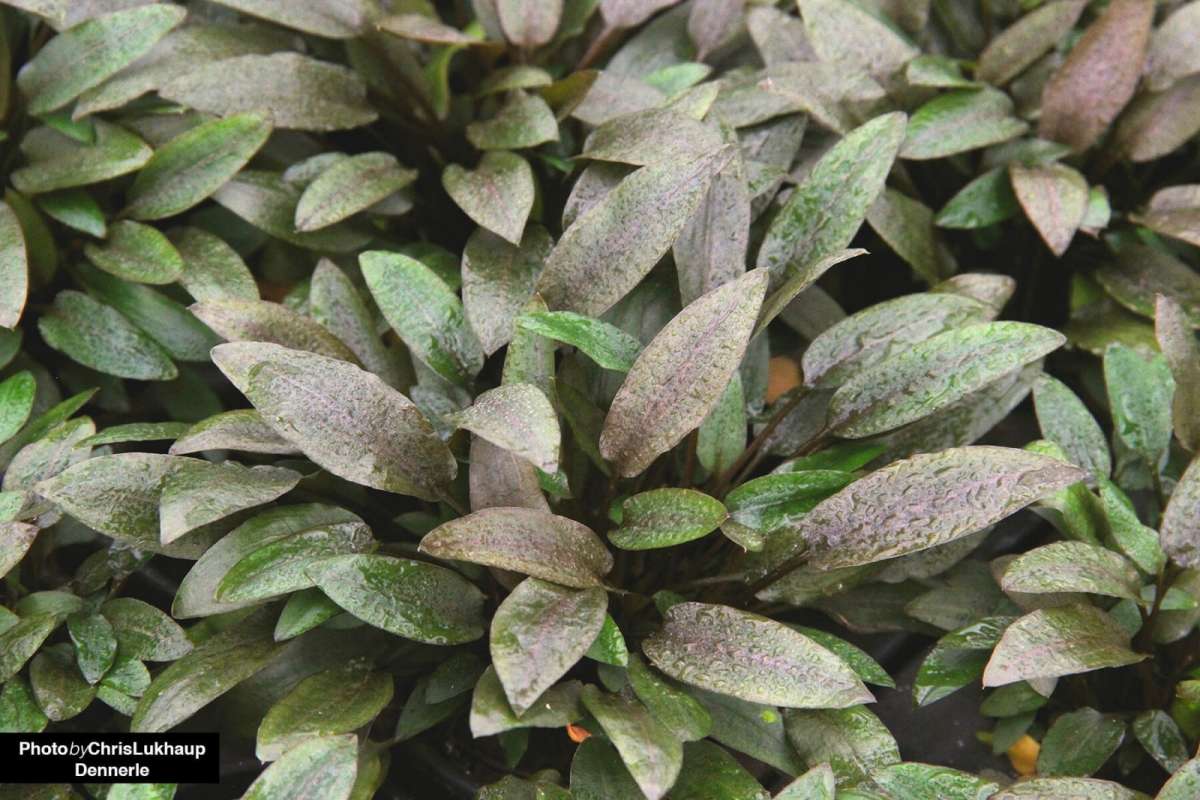
Planting stem plants
Stem plants should be prepared before planting. After removing the ceramic ring, lead tape or rockwool, cut off about one centimetre of the stem end, also remove yellow leaflets. The lowest leaves of the stem are cut off so that a small part of the leaf style remains. These then act as a barb when inserted and give the still fresh and unrooted plant a better hold in the substrate until it has re-rooted. To do this, you can hold the plant with your fingers and press it into the substrate, but it is advantageous to use blunt and straight tweezers.
Planting InVitro plants
In vitro plants are grown in the same way in the small pots in which they are sold and come from the laboratory. Even though they are somewhat smaller, they grow quickly in the aquarium, so they are hardly any different from the much larger potted or bunched plants. They are pesticide and parasite free and sit in a nutrient gel or liquid. This is washed off or removed and without watering they may be placed directly into the aquarium. These should also be divided up.
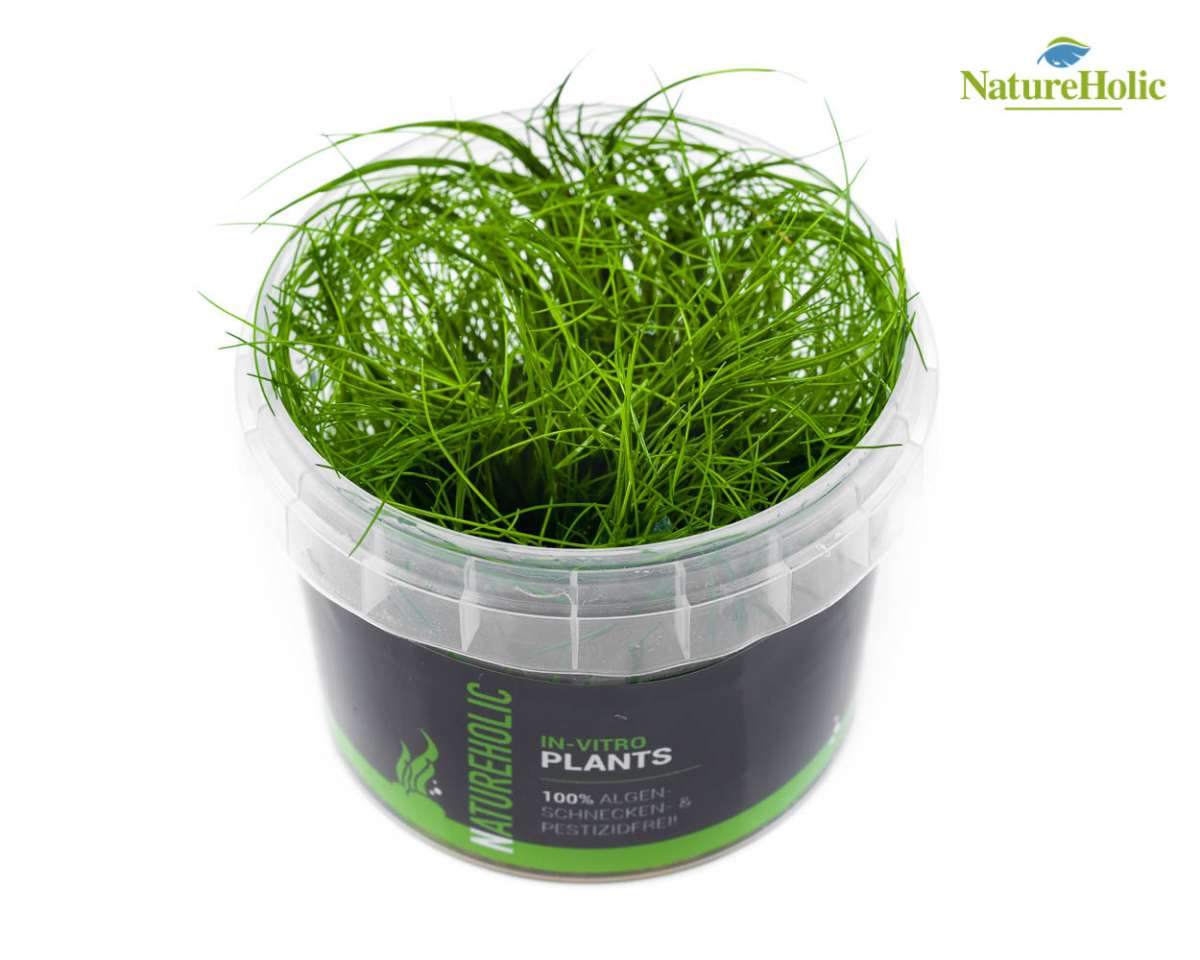
Perching plants and mosses
Anubias, Bucephalandra and mosses are usually available ready tied up or glued to stone plates or roots. These can simply be decorated in the aquarium after watering. As a rule, perching plants should not be planted in the substrate, as their rhizome could rot, causing the plant to die. Alternatively, it can be stuck into cracks in stones, from where the plant will continue to grow. Mosses can also be stuck, but it makes more sense to tie them on carefully with a string or to glue them on with a plant adhesive gel. The moss will then simply continue to grow on the spot.
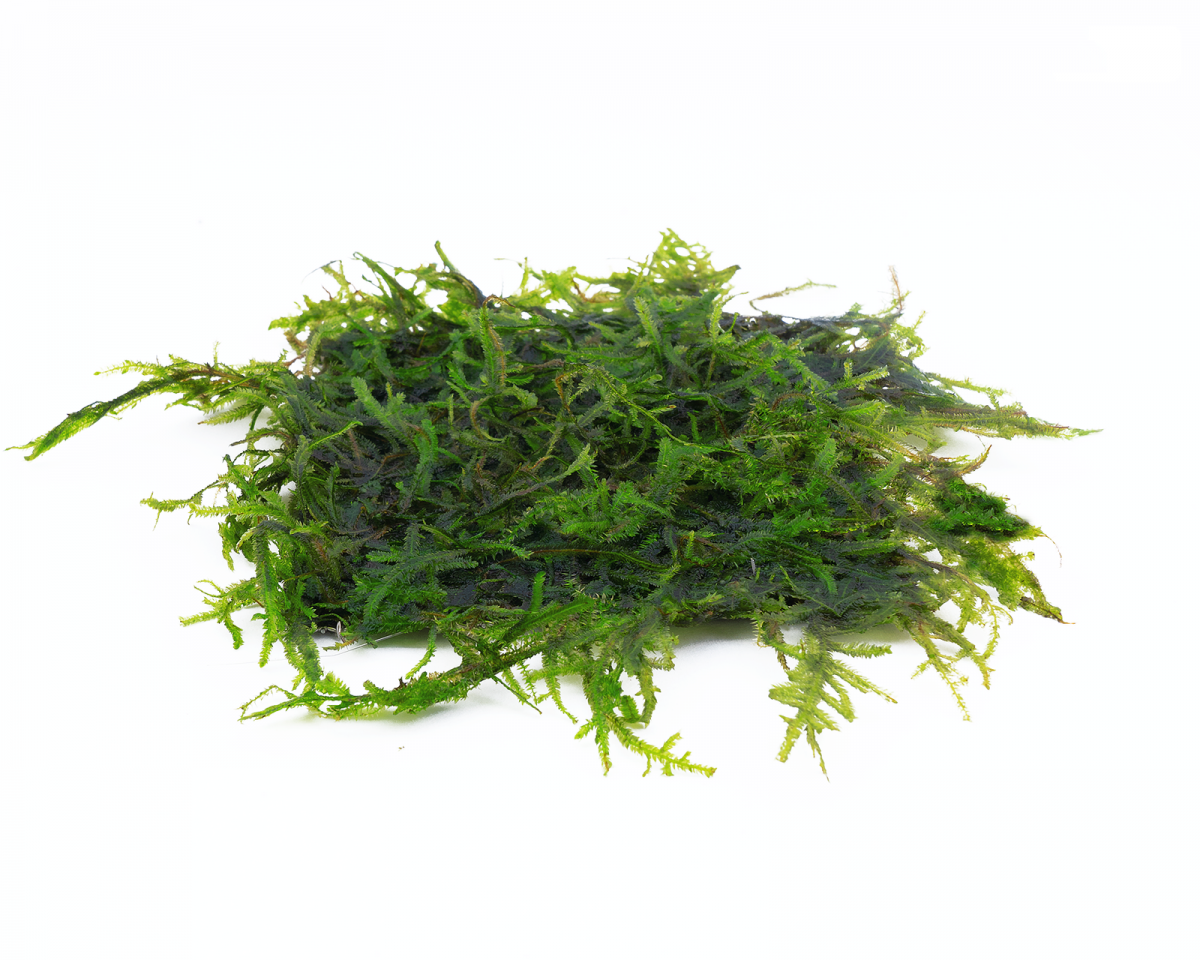
Care and propagation of aquarium plants
Every now and then, the plants in the aquarium should be given a little shaping.
Stem plants
can sometimes reach up to 60 cm in height and even continue to grow above the water surface. These can be cut off 1/3 below the surface with straight and sharp scaping scissors. To avoid bruising the plant and injuring it in the process, it is advisable not to pinch it off with your fingernails but to cut it off smoothly.
These plant tips can simply be replanted next to it with blunt tweezers and will then continue to grow, as will the trimmed plant.
Mosses
can be easily divided and propagated by plucking or cutting. Some mosses form cushions that detach themselves over time and settle somewhere in the aquarium where they continue to grow. Controlled trimming is therefore recommended to prevent this.
Perennialplants
reproduce via their rhizome and usually grow rather slowly. To propagate or trim them, cut off a piece of the rhizome that has at least three leaves. This can then be tied or glued on.
Ground cover
can easily be trimmed under water with so-called wave scissors. The parts of the plant that float to the surface can then simply be cut off.
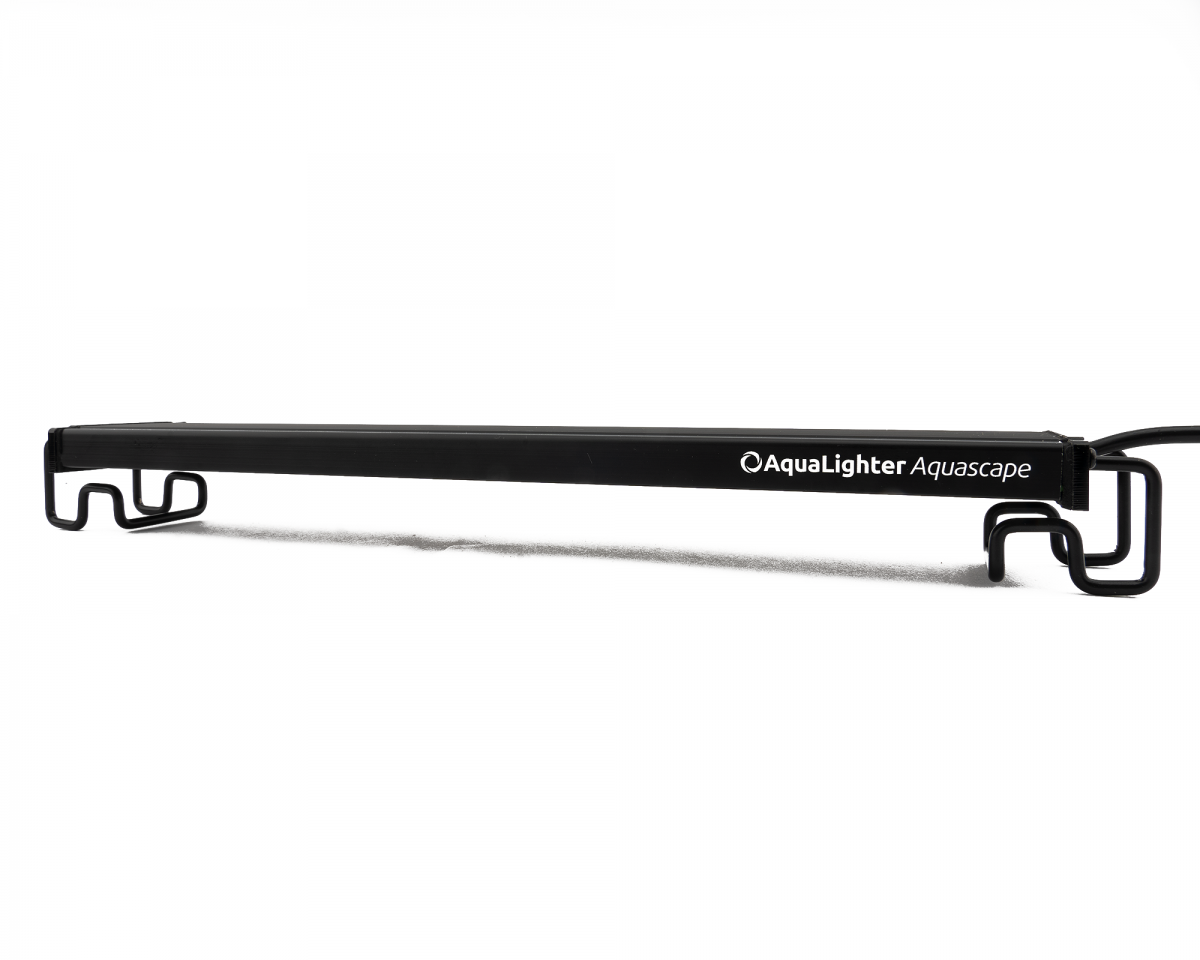
Growth factors - nutrients and lighting
Plants, too, are living creatures that can "ail" from time to time and require special attention. This is usually noticeable by colour loss, but in the case of extreme nutrient deficiencies of certain species also by colour intensity. However, deficiencies can be recognised and remedied above all by their appearance. Basically, plant growth depends on the interaction of certain macro- and micronutrients and their relationship to each other: if, for example, certain substances are lacking on one side, their uptake on the other side is inhibited or even impossible(Liebig's minimum law). Every process in the aquarium is always dependent on its counterpart in order to function optimally.
Thus, it does not matter if a nutrient that is already sufficiently available is added, because the growth of the plant is oriented towards the ratio of the scarcest available resource. This imbalance provides algae, for example, with a nutritious buffet that can only be brought back into balance by compensating for the missing resource. In short, fertilising can help prevent excessive algae growth.
Iron chlorosis
If the leaves lose their colour and become yellowish, this is probably due to iron chlorosis. In this case, chlorophyll production is reduced or even inhibited. Several enzyme processes in photosynthesis depend on iron as an electron carrier. Targeted iron fertilisation can restore the nutrient balance in the aquarium.
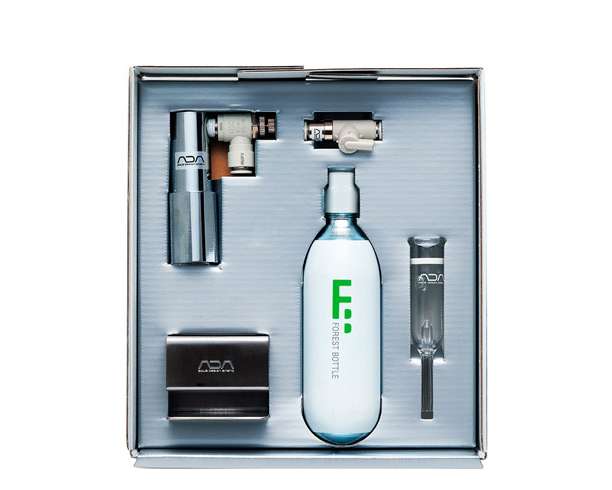
Lighting and CO2 as fuel
Lighting duration and intensity play at least as important a role in plant care as the micro-/macronutrient composition. The higher and more intensively the aquarium is lit, the higher the demand for CO2. Theoretically, it is possible to run an aquarium without any carbon dioxide at all, but in this case only plants with a rather low demand can be maintained, such as Anubias, Bucephalandra, Vallisneria, Cryptocorynes and Javafarn.
CO2 also has an effect on the pH value and the carbonate hardness in the aquarium: the water is slightly acidified by carbon dioxide and lowers the pH value. Since most animals kept in the aquarium come from rather acidic areas anyway, this is quite advantageous. High carbonate hardnesses are strongly buffered against CO2 and pH value fluctuations and stabilise. Ideally, the CO2 content in the water should be permanently monitored with a drop checker.
Biogenic decalcification
Especially in heavily planted aquascapes, CO2 can become a scarce commodity. Some plants are able to cover their carbon dioxide needs from hydrogen carbonates by releasing hydroxide ions into the aquarium water, which leads to an increase in the pH value. This phenomenon is visually recognisable by white and crumbly lime coatings on the tops of leaves and is also called "biogenic decalcification". However, such an imbalance can be life-threatening for the animals being kept, which is why the CO2 supply should be correctly adjusted and monitored.
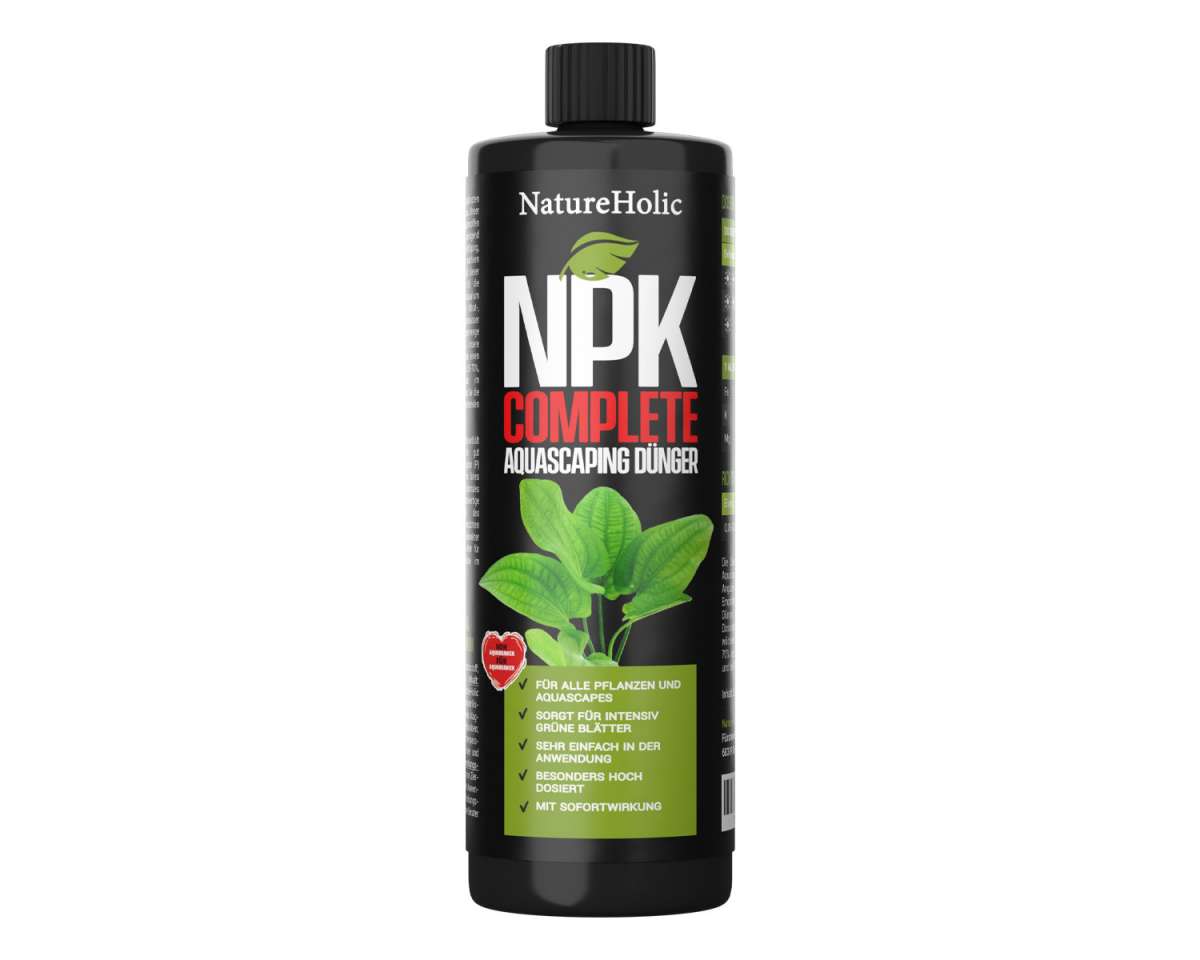
Fertiliser
"Everyone who lives wants to eat something"- this also applies to plants and therefore they are dependent on what is made available to them. Water changes remove nutrients, but also add them, which sometimes leads to imbalances in the nutritional balance. But also the fish stocking or just the lack of it are main factors for fertilisation in the aquarium. Fish, their feeding and excretions often supply large amounts of phosphate and nitrogen which, on the other hand, are absent or only present to a limited extent in a purely planted aquascape. This is also the difference between so-called "complete fertilisers", which are usually designed for these community aquariums.
Plants also differ in the way they absorb nutrients, some need leaf fertilisation, others root fertilisation. Especially rosette plants such as cryptocorynes need targeted root fertil isation in the form of tablets or capsules after a certain point, when the nutrient supply in the substrate is no longer sufficient.
Calculation of requirements
To determine the correct requirement of the necessary nutrients, the aquarium water should be checked regularly with a drop test. The most important macronutrients are: nitrogen, phosphate, potassium, oxygen, hydrogen, magnesium, sulphur and calcium.
These depend on the proportion of micronutrients that are also present in order to function optimally: Iron, Manganese, Molybdenum, Copper, Zinc, Boron, Nickel, Cobalt and Chlorine.
Chelators and complexing agents in fertilisers such as HEEDTA, DTPA and EDTA are responsible for nutrient stabilisation and availability in the water and decide on nutrient supply, which also depends on the pH value. Different stable chelate complexes are suitable for different purposes, such as preventing the precipitation of iron and phosphate into iron phosphate, which plants, for example, cannot absorb.
Even if the topic of plant fertilisation looks like a book with seven seals at first glance, we offer simple solutions in the form of fertilisers in our shop that are very easy to use: Prepared mixtures, such as an NPK fertiliser, can simply be used according to instructions. But individual nutrients such as potassium or iron can also be added in a targeted manner. Especially the active non-supply of aquatic plants, which unfortunately is still practised by many aquarists, often leads to imbalances in the small biotope, which then gets out of balance and can cause further problems.
In the next part, we will look at aquarium set-up, water treatment and other exciting topics, so that you can care for and nurture your aquarium and your animals without any worries. Stay tuned!
